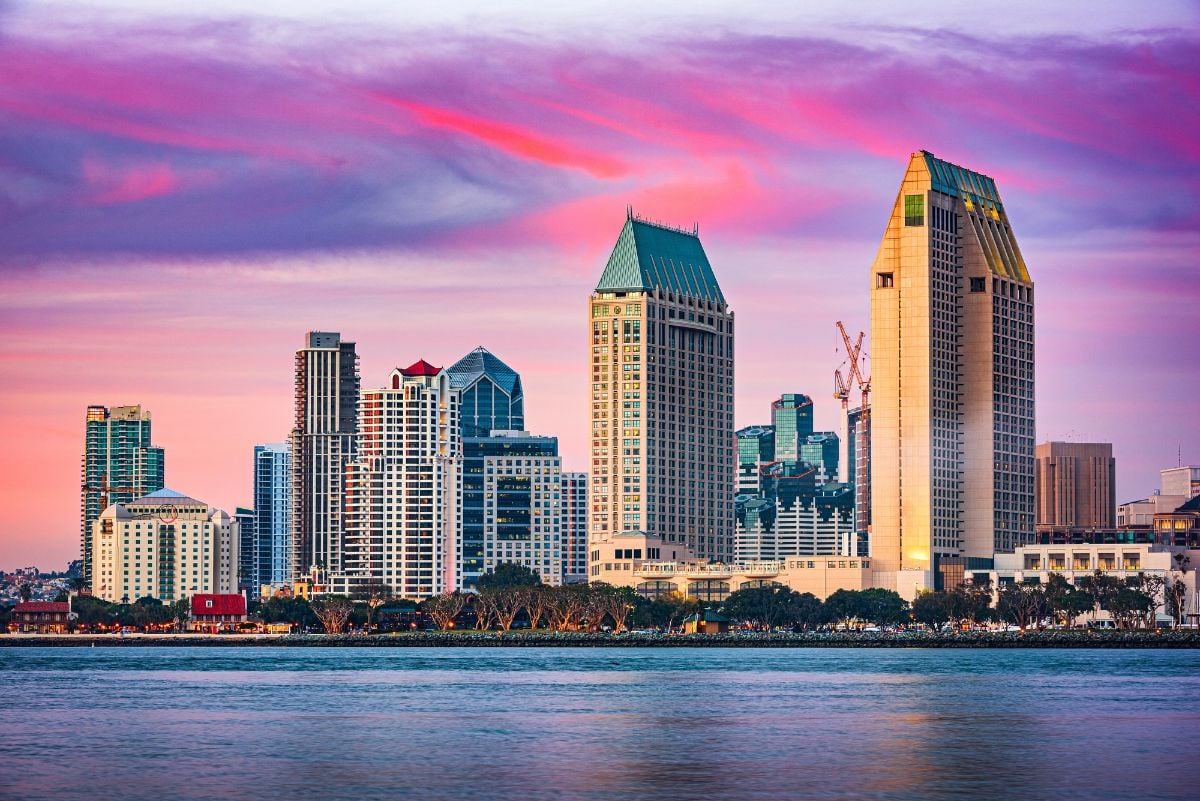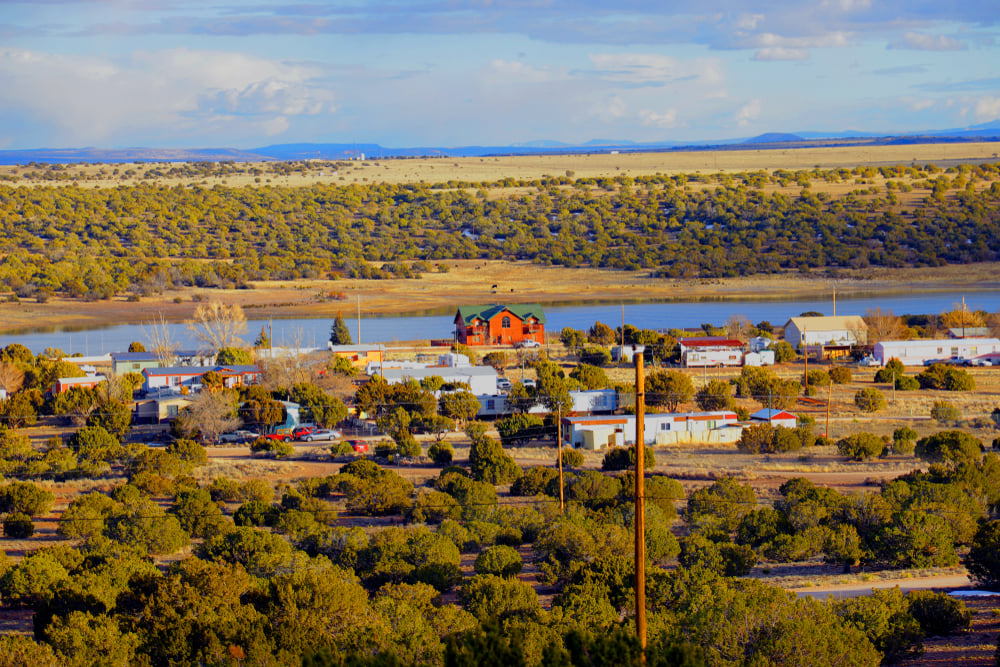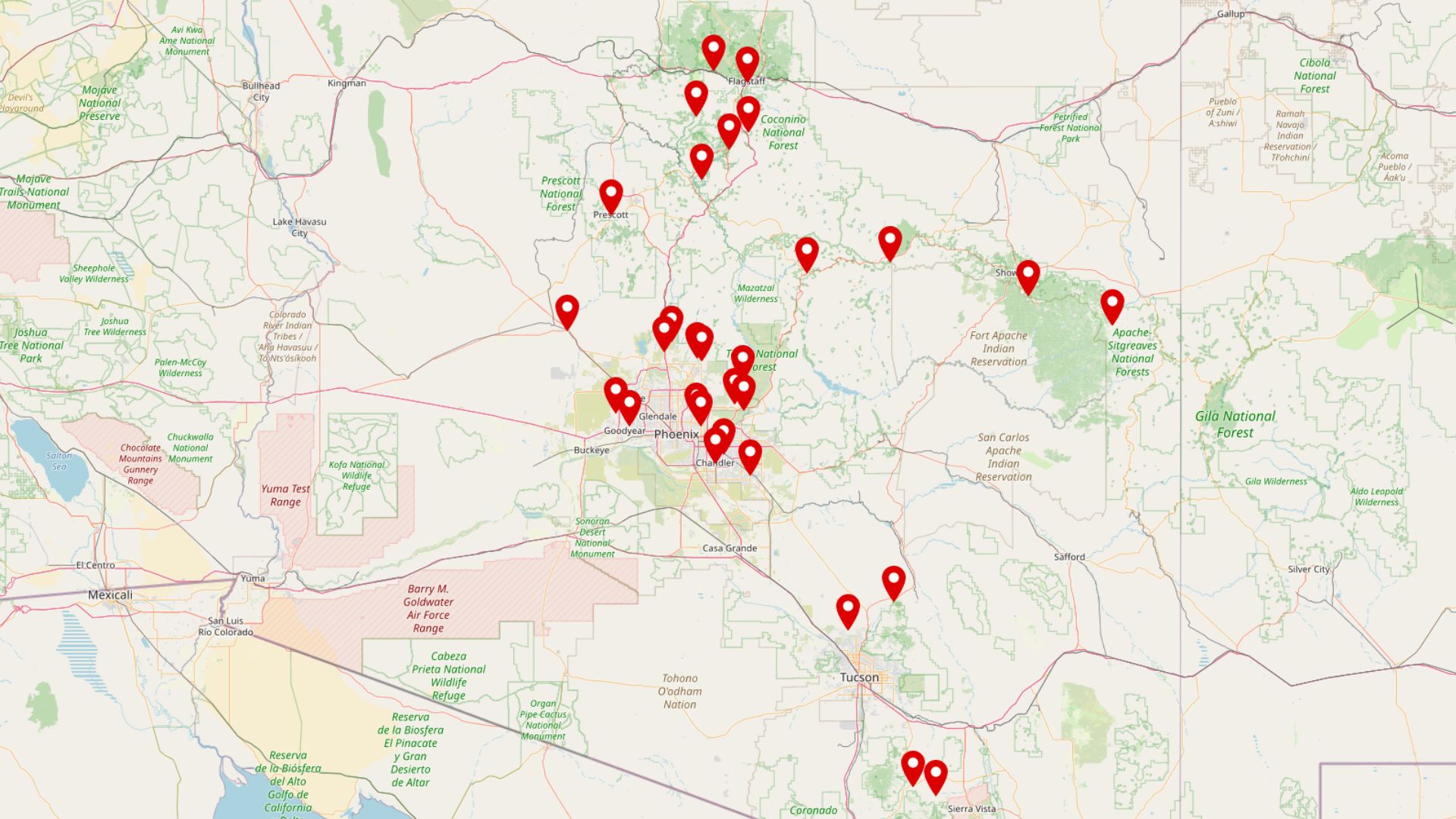
Based on the latest Zillow Home Value Index data from July 2025, we’ve identified the 30 most expensive towns in Arizona by current home prices. These communities represent the pinnacle of desert luxury living, where million-dollar price tags have become the norm rather than the exception. Each location offers unique attractions that justify premium real estate values.
From Paradise Valley’s celebrity estates to Cave Creek’s Western charm, these towns showcase Arizona’s diverse appeal to affluent buyers. Whether you’re considering an investment, planning a move, or simply curious about the state’s luxury market, this comprehensive breakdown reveals where Arizona’s highest property values are concentrated and what drives demand in each community.
30. Star Valley – 133% Home Price Increase Since 2010

- 2010: $222,729
- 2011: $197,036
- 2012: $204,311
- 2013: $216,809
- 2014: $226,835
- 2015: $248,591
- 2016: $261,957
- 2017: $273,790
- 2018: $299,767
- 2019: $333,176
- 2020: $347,464
- 2021: $444,611
- 2022: $528,952
- 2023: $497,967
- 2024: $526,113
- 2025: $518,840
Star Valley has experienced remarkable growth since hitting bottom in 2011, with values more than doubling from that low point. The town saw its biggest surge during the pandemic years, jumping from $347,464 in 2020 to over $528,000 by 2022. Despite some volatility in recent years, median home prices in July 2025 reached $518,840, reflecting sustained demand in this Arizona community.
Why Star Valley?
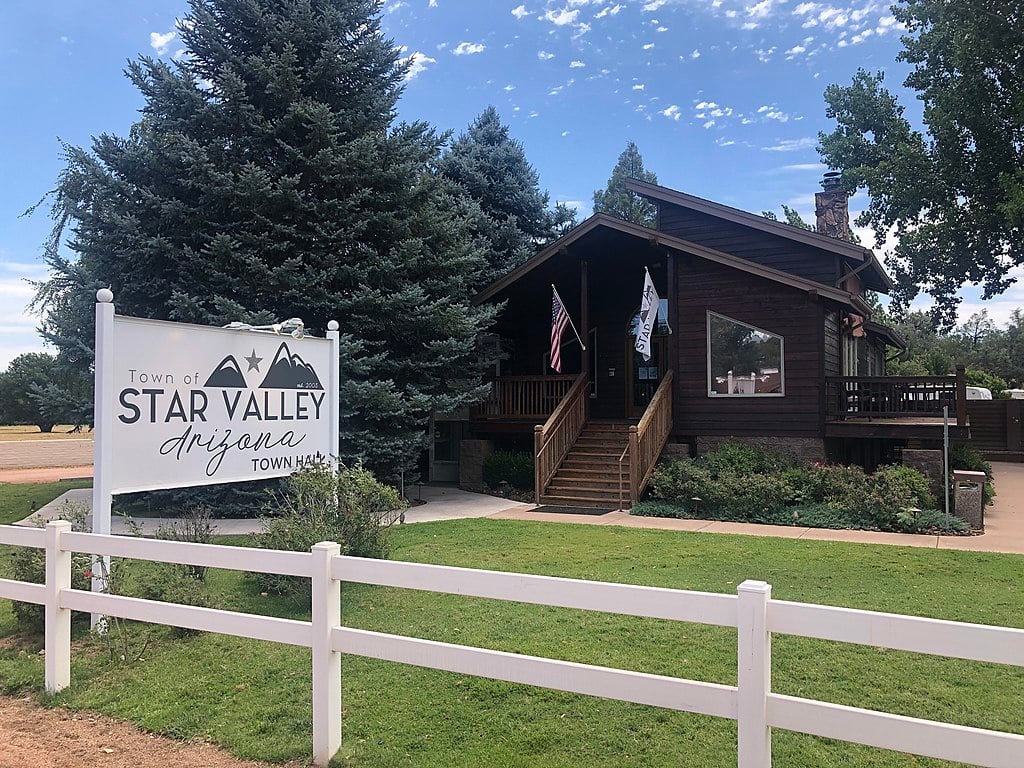
Why are people willing to pay so much to live here? What’s special about it?
Star Valley attracts buyers seeking mountain living within reach of Phoenix metro amenities. The town offers cooler temperatures than the desert floor, pine-covered landscapes, and outdoor recreation opportunities year-round. Residents value the small-town atmosphere, lower crime rates, and scenic beauty that provides a stark contrast to urban Arizona living.
Unlike the desert cities below, Star Valley features seasonal weather changes and forest surroundings that appeal to those wanting four seasons. The area’s limited development and rural character help maintain property values while offering larger lots and custom homes. Access to hiking, fishing, and winter sports within a short drive adds to the area’s appeal for active lifestyles.
How Star Valley Rose to Prominence
Star Valley’s development began as a summer retreat destination for Phoenix residents seeking escape from desert heat. Located in the high country of Gila County, the area was originally settled by ranchers and miners in the late 1800s. The cooler climate and natural springs made it an attractive location for livestock and small-scale agriculture during Arizona’s territorial period.
As Phoenix grew throughout the 20th century, Star Valley evolved into a vacation home community for affluent valley residents. The construction of improved roads and utilities in the 1980s and 1990s made year-round living more feasible. Today, it attracts both retirees seeking a mountain lifestyle and remote workers who can live anywhere while maintaining proximity to major metropolitan areas.
3 Interesting Tidbits
1. Elevation Advantage – Star Valley sits at over 4,000 feet elevation, providing temperatures that average 15-20 degrees cooler than Phoenix year-round.
2. Water Features – The area is home to several natural springs and seasonal creeks, rare features in Arizona that enhance property desirability and recreational opportunities.
3. Wildlife Haven – Residents regularly spot elk, deer, and black bears, making it one of the few Arizona communities where mountain wildlife encounters are common.
29. Waddell – 197% Home Price Increase Since 2010
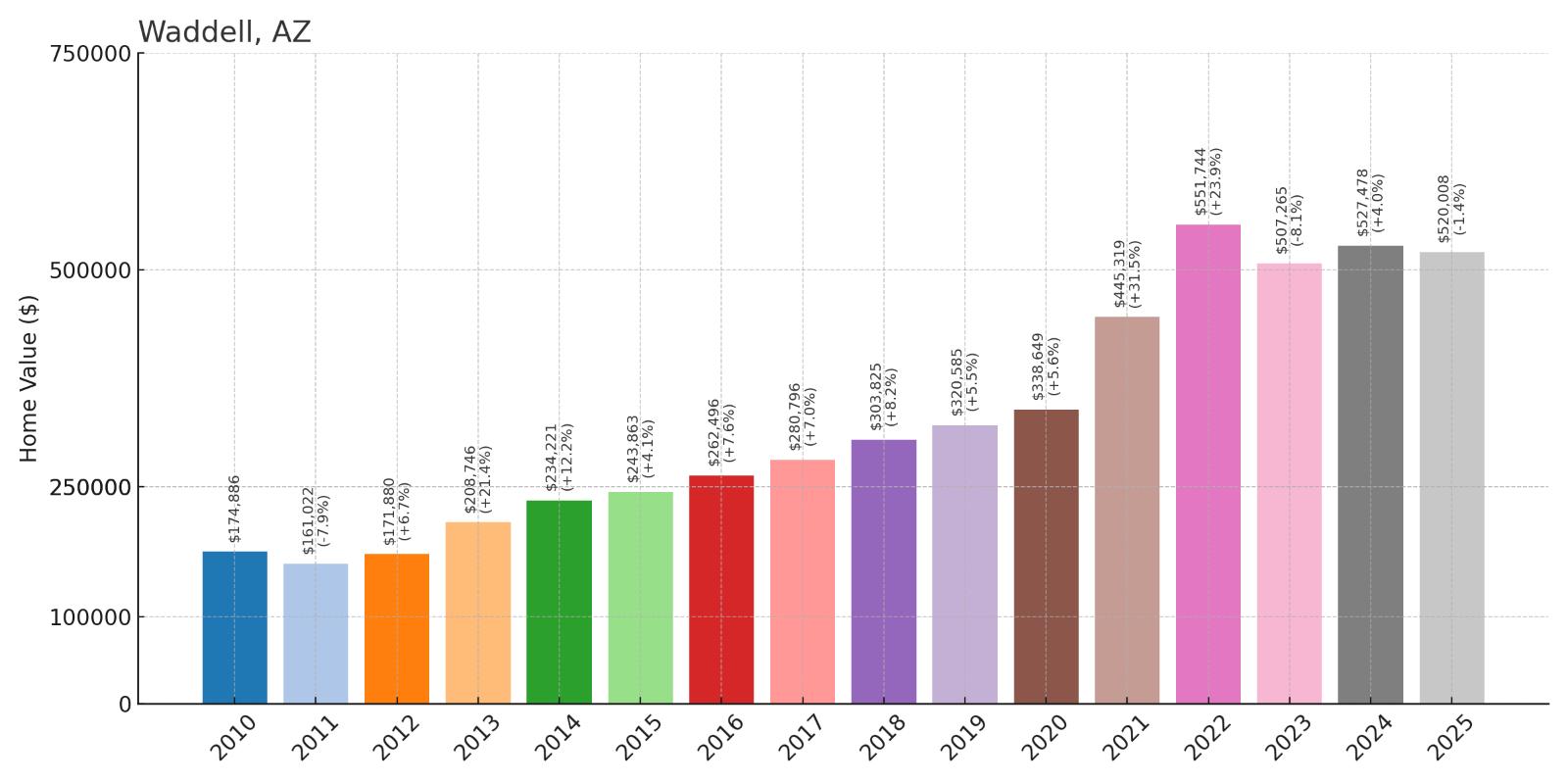
- 2010: $174,886
- 2011: $161,022
- 2012: $171,880
- 2013: $208,746
- 2014: $234,221
- 2015: $243,863
- 2016: $262,496
- 2017: $280,796
- 2018: $303,825
- 2019: $320,585
- 2020: $338,649
- 2021: $445,319
- 2022: $551,744
- 2023: $507,265
- 2024: $527,478
- 2025: $520,008
Waddell shows impressive nearly 200% growth since 2010, recovering strongly from the housing crisis low of $161,022 in 2011. The community experienced dramatic appreciation during the pandemic boom, with values jumping from $338,649 in 2020 to over $550,000 by 2022. Current median prices of $520,008 reflect the area’s transformation into a sought-after West Valley location.
Why Waddell?
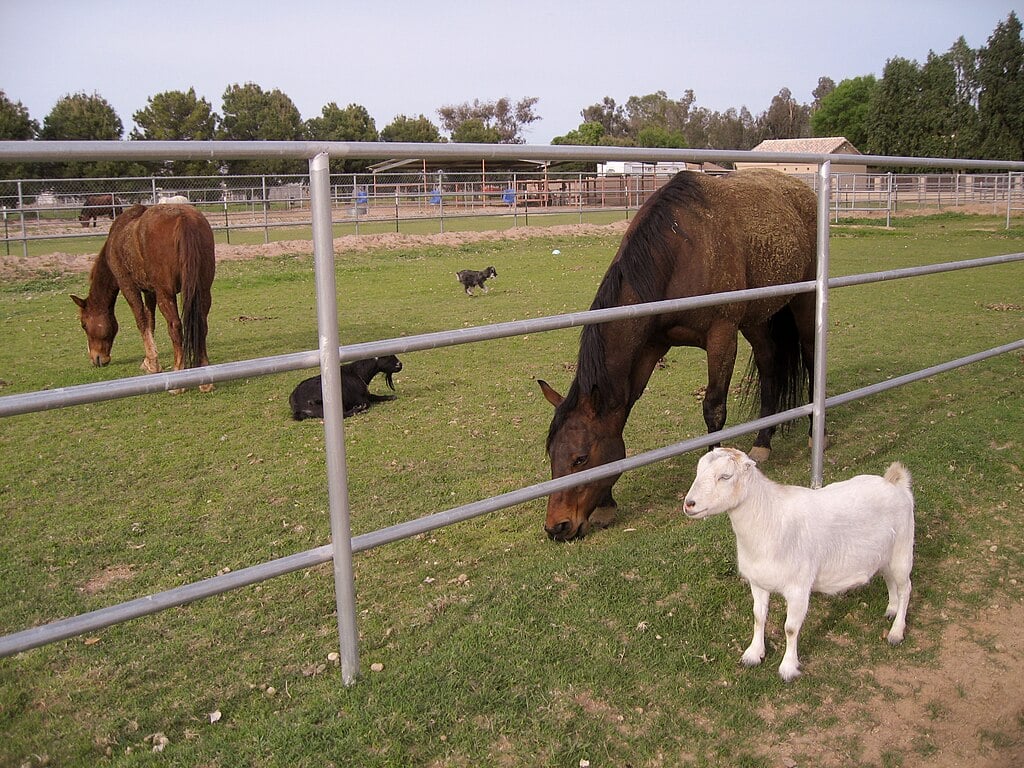
Why are people willing to pay so much to live here? What’s special about it?
Waddell attracts buyers looking for affordable luxury in the expanding West Valley corridor. The area offers newer construction, larger lots, and mountain views without the premium prices of North Scottsdale or Paradise Valley. Families appreciate the master-planned communities, excellent schools, and recreational amenities that provide resort-style living at more accessible price points.
The community benefits from its proximity to Lake Pleasant Regional Park, offering boating, fishing, and water sports just minutes away. Unlike more crowded Phoenix suburbs, Waddell maintains an open feel with desert landscapes and hiking trails. The area’s continued development attracts young professionals and families seeking modern amenities in a less congested setting.
How Waddell Rose to Prominence
Waddell’s prominence emerged from Phoenix’s westward expansion and the development of Loop 303, which improved access to this formerly remote area. Originally part of the Hieroglyphic Mountains ranching region, the area remained largely undeveloped until the late 1990s when master-planned communities began taking shape. The proximity to Luke Air Force Base also contributed to early residential development.
The 2000s brought major residential developments that transformed Waddell from ranch land into a suburban community. Developers capitalized on affordable land prices and dramatic Sonoran Desert settings to create family-oriented neighborhoods. The completion of major infrastructure projects and the expansion of shopping and dining options solidified Waddell’s reputation as an emerging West Valley destination.
3 Interesting Tidbits
1. Lake Access – Waddell provides some of the closest residential access to Lake Pleasant, Arizona’s premier boating and fishing destination.
2. Aviation Heritage – The nearby Luke Air Force Base influences the area’s development and provides economic stability to the region.
3. Desert Preserve – The community features extensive desert preserve areas that maintain the natural Sonoran landscape while providing hiking and wildlife viewing opportunities.
28. Oracle – 141% Home Price Increase Since 2010
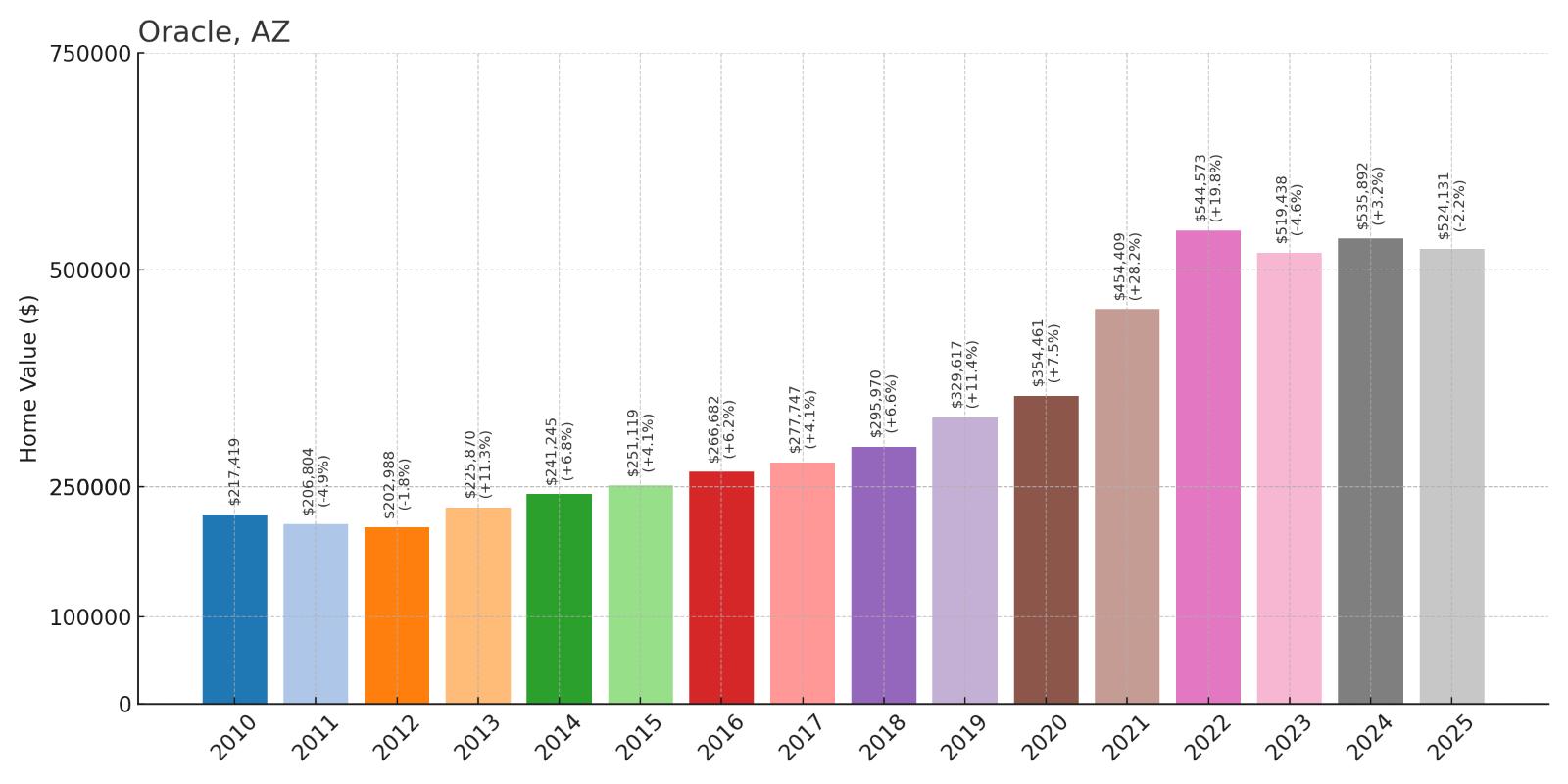
- 2010: $217,419
- 2011: $206,804
- 2012: $202,988
- 2013: $225,870
- 2014: $241,245
- 2015: $251,119
- 2016: $266,682
- 2017: $277,747
- 2018: $295,970
- 2019: $329,617
- 2020: $354,461
- 2021: $454,409
- 2022: $544,573
- 2023: $519,438
- 2024: $535,892
- 2025: $524,131
Oracle demonstrates steady appreciation with 141% growth since 2010, showing remarkable consistency compared to other Arizona markets. The town avoided the dramatic dips seen elsewhere, maintaining gradual upward momentum through most periods. Home values accelerated significantly during 2020-2022, reaching a peak of $544,573 before stabilizing around $524,131 in July 2025.
Why Oracle?
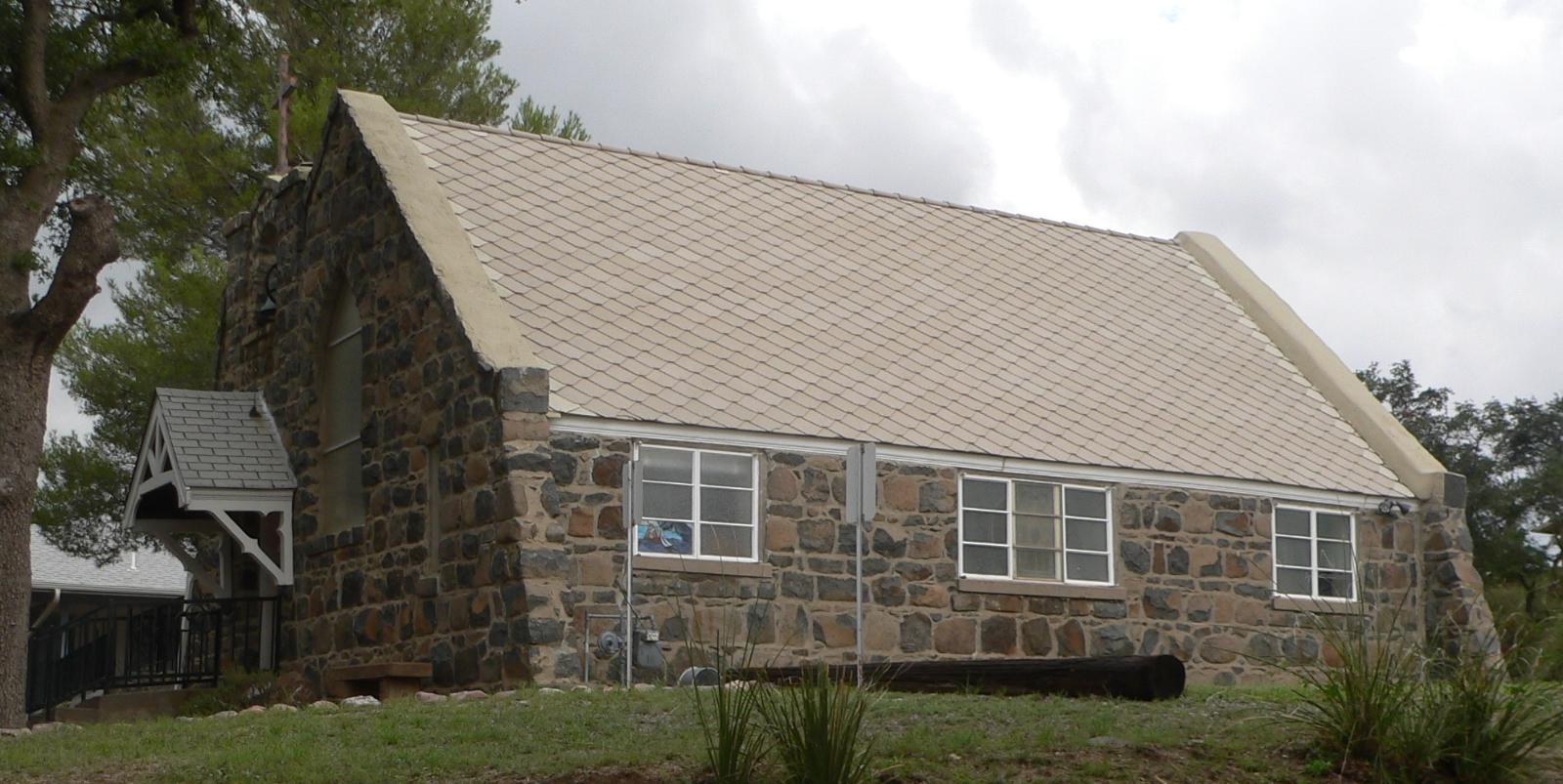
Why are people willing to pay so much to live here? What’s special about it?
Oracle appeals to buyers seeking rural tranquility with spectacular desert mountain views and cooler temperatures than the valley floor. The community offers large parcels, custom homes, and a slower pace of life while remaining within commuting distance of Tucson. Residents value the area’s dark skies, wildlife viewing opportunities, and proximity to outdoor recreation in the Santa Catalina Mountains.
The town’s elevation provides relief from extreme desert heat, making it attractive to retirees and those seeking year-round outdoor activities. Unlike developed resort areas, Oracle maintains its small-town character with local businesses and community events. The area’s natural beauty and limited development preserve property values while offering privacy and space rare in Arizona’s urban areas.
How Oracle Rose to Prominence
Oracle’s prominence dates to its founding as a mining camp in the 1880s, named after the Oracle Mining Company’s successful gold and silver operations. The town served as a supply center for numerous mines in the surrounding mountains and became a stop on the early road connecting Tucson to Phoenix. During its mining heyday, Oracle supported several thousand residents and numerous businesses.
After the mining boom ended, Oracle evolved into a ranching community and eventually a destination for those seeking rural living near Tucson. The construction of better roads in the mid-20th century made the area more accessible, attracting retirees and weekend residents. Today’s Oracle combines its Old West heritage with modern amenities, appealing to buyers who want history, natural beauty, and proximity to urban services.
3 Interesting Tidbits
1. Observatory Connection – Oracle is home to several astronomical observatories, taking advantage of the area’s clear skies and minimal light pollution.
2. Mining Legacy – Historic mining sites and remnants scattered throughout the area provide glimpses into Arizona’s territorial period and the Old West.
3. Biosphere 2 – The famous Biosphere 2 research facility is located nearby, making Oracle a center for environmental and space research activities.
27. Litchfield Park – 191% Home Price Increase Since 2010

- 2010: $180,120
- 2011: $164,738
- 2012: $185,624
- 2013: $226,779
- 2014: $250,219
- 2015: $259,834
- 2016: $279,719
- 2017: $295,743
- 2018: $317,371
- 2019: $332,502
- 2020: $362,060
- 2021: $461,246
- 2022: $571,142
- 2023: $523,150
- 2024: $538,185
- 2025: $524,496
Litchfield Park achieved exceptional 191% growth since 2010, recovering dramatically from its 2011 low to current values exceeding $524,000. The community experienced its largest gains during 2013-2014 and again during the pandemic surge of 2020-2022. Despite recent market adjustments, July 2025 prices of $524,496 reflect strong ongoing demand for this established West Valley community.
Why Litchfield Park?

Why are people willing to pay so much to live here? What’s special about it?
Litchfield Park attracts buyers seeking established neighborhoods with mature trees, golf course living, and a resort atmosphere in the West Valley. The community offers a rare combination of small-town charm and upscale amenities, including the prestigious Wigwam Golf Resort. Families appreciate the excellent schools, safe neighborhoods, and community events that create a strong sense of belonging.
Unlike newer developments, Litchfield Park features tree-lined streets, established landscapes, and historic architecture that gives it distinctive character. The town’s compact size makes everything walkable, while its central location provides easy access to downtown Phoenix and Sky Harbor Airport. Residents enjoy golf, tennis, and spa amenities typically found only in expensive resort communities.
How Litchfield Park Rose to Prominence
Litchfield Park’s prominence began in 1916 when Goodyear Tire and Rubber Company founder Paul Litchfield established the community as a company town for cotton farming. The area was designed as a master-planned community with wide boulevards, parks, and the iconic Wigwam resort, which opened in 1929. The town’s layout and architecture reflected the best planning principles of the early 20th century.
After World War II, Litchfield Park transitioned from an agricultural company town to an upscale residential community. The preservation of its original design elements, including the historic downtown and resort, helped maintain its unique character as the Valley grew around it. Today’s Litchfield Park successfully balances its historic heritage with modern amenities, creating a distinctive lifestyle that commands premium prices.
3 Interesting Tidbits
1. Company Town Heritage – Litchfield Park was one of America’s first planned company towns, designed with advanced urban planning concepts for its era.
2. Resort Legacy – The Wigwam resort has hosted celebrities and dignitaries since the 1920s, establishing the area’s luxury reputation.
3. Tree City USA – The community maintains its Tree City USA designation, rare in Arizona, thanks to extensive urban forestry and mature landscaping.
26. Bellemont – 176.9% increase since 2013
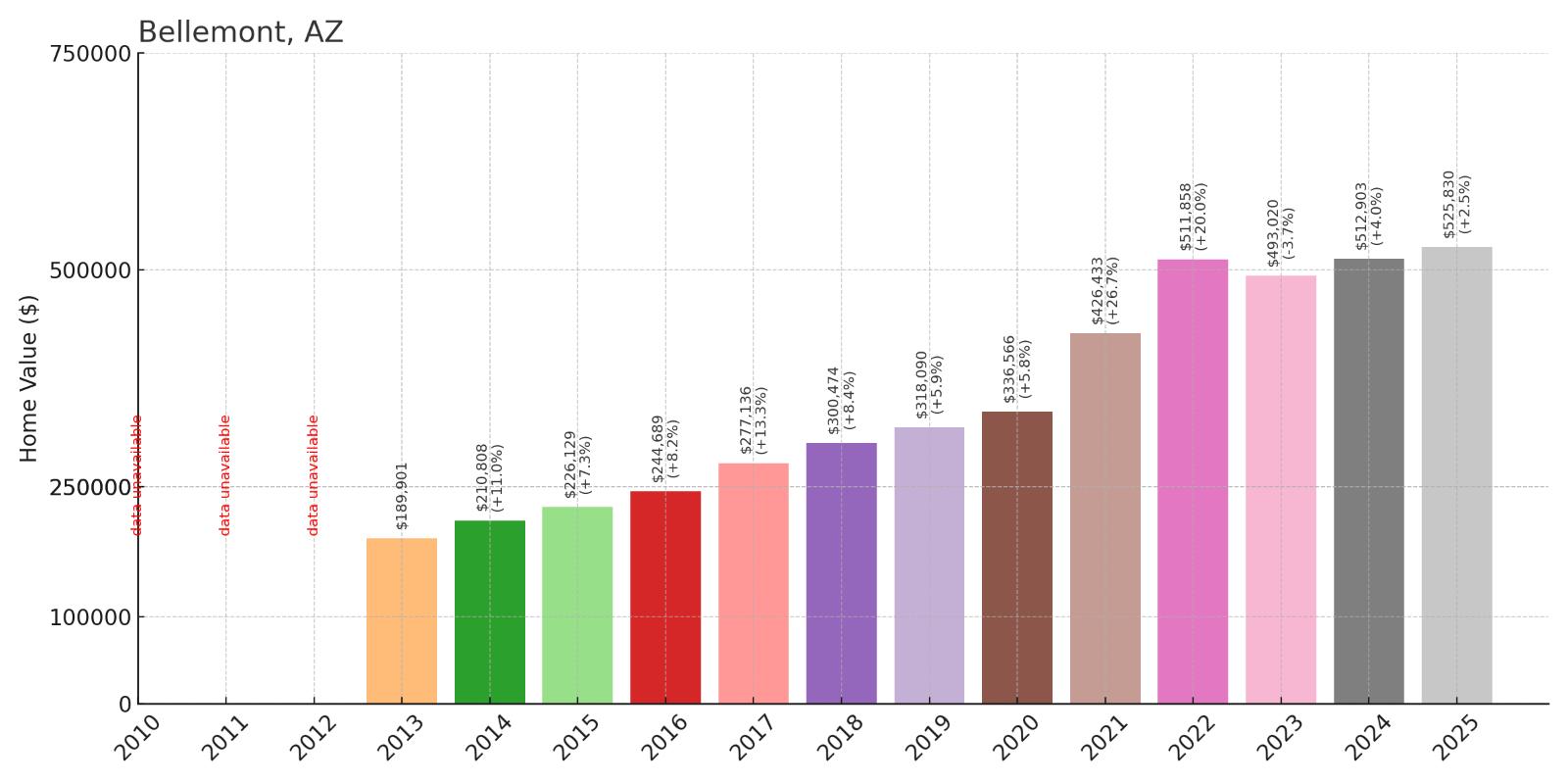
- 2010: N/A
- 2011: N/A
- 2012: N/A
- 2013: $189,901
- 2014: $210,808
- 2015: $226,129
- 2016: $244,689
- 2017: $277,136
- 2018: $300,474
- 2019: $318,090
- 2020: $336,566
- 2021: $426,433
- 2022: $511,858
- 2023: $493,020
- 2024: $512,903
- 2025: $525,830
Bellemont shows strong appreciation since data became available in 2013, with a 177% increase over twelve years. The community experienced steady growth through most periods, with particularly strong gains during 2021-2022 when values jumped from $336,566 to over $511,000. Current median prices of $525,830 reflect continued demand for this northern Arizona mountain community.
Why Bellemont?

Why are people willing to pay so much to live here? What’s special about it?
Bellemont attracts buyers seeking mountain living with four seasons and proximity to Flagstaff’s amenities. The area offers cooler temperatures, pine forests, and snow in winter while maintaining reasonable access to urban services. Residents value the outdoor recreation opportunities, including skiing, hiking, and camping, along with the small-town atmosphere and scenic mountain views.
Unlike desert communities, Bellemont provides a true mountain lifestyle with seasonal weather changes and forest surroundings. The area appeals to those wanting to escape Arizona’s heat while remaining in-state for tax and other benefits. Limited development and rugged terrain help preserve the natural character that drives property values in this elevated community.
How Bellemont Rose to Prominence
Bellemont’s prominence began as a railroad stop on the Atlantic and Pacific Railroad in the 1880s, serving as a logging and ranching center in the Coconino National Forest region. The community’s name honors Belle Rogers, daughter of a local ranch owner, reflecting its frontier heritage. The railroad connection made Bellemont an important supply point for lumber operations and cattle ranching throughout northern Arizona.
As the lumber industry declined, Bellemont evolved into a gateway community for outdoor recreation and a residential area for those working in Flagstaff. The construction of Interstate 40 improved access while the growth of Northern Arizona University increased demand for housing alternatives to urban Flagstaff. Today’s Bellemont combines its railroad heritage with modern mountain living, attracting buyers seeking authentic Arizona high country experiences.
3 Interesting Tidbits
1. Railroad Heritage – Historic railroad buildings and artifacts throughout the community reflect its origins as a key stop on the transcontinental railroad.
2. Forest Access – Bellemont provides direct access to thousands of acres of Coconino National Forest for hiking, camping, and outdoor recreation.
3. Weather Station – The area hosts weather monitoring equipment that tracks conditions for northern Arizona, including snowfall and temperature data.
25. Chandler – 156% Home Price Increase Since 2010

- 2010: $205,945
- 2011: $178,553
- 2012: $195,236
- 2013: $237,679
- 2014: $260,701
- 2015: $269,854
- 2016: $286,264
- 2017: $299,749
- 2018: $322,494
- 2019: $339,979
- 2020: $370,746
- 2021: $464,602
- 2022: $575,287
- 2023: $524,502
- 2024: $543,858
- 2025: $526,222
Chandler achieved solid 156% growth since 2010, demonstrating resilience through market cycles with steady upward momentum. The city recovered strongly from its 2011 low, showing consistent appreciation through the decade. Home values accelerated during the pandemic period, reaching $575,287 in 2022 before moderating to $526,222 in July 2025, reflecting the maturation of this major East Valley city.
Why Chandler?

Why are people willing to pay so much to live here? What’s special about it?
Chandler attracts buyers seeking a perfect balance of suburban amenities, economic opportunity, and master-planned community living. The city offers excellent schools, diverse housing options, and a thriving job market anchored by major technology companies. Families value the safe neighborhoods, recreational facilities, and cultural attractions that provide big-city amenities with community feel.
Unlike smaller towns, Chandler provides urban sophistication with shopping, dining, and entertainment options while maintaining manageable traffic and suburban character. The city’s strong economic base, including major employers like Intel and Wells Fargo, creates job opportunities that support higher housing costs. Planned communities offer resort-style amenities and golf courses that enhance the lifestyle appeal.
How Chandler Rose to Prominence
Chandler’s prominence began in 1912 when Dr. Alexander John Chandler established the town as an agricultural community in the Salt River Valley. His vision included modern irrigation systems and planned development that attracted farmers and businesses to the area. The community grew steadily through the early 20th century as cotton farming and citrus growing flourished in the desert climate.
The transformation to a major suburban center began in the 1980s when technology companies started relocating to the Phoenix area, with Chandler offering available land and pro-business policies. Intel’s arrival in 1980 marked the beginning of the city’s evolution into a technology hub, followed by other major corporations. Today’s Chandler successfully balances its agricultural heritage with high-tech industry, creating a diverse economy that supports premium real estate values.
3 Interesting Tidbits
1. Tech Hub – Chandler hosts one of Intel’s largest manufacturing facilities, making it a center for semiconductor production and high-tech employment.
2. Ostrich Festival – The annual Chandler Ostrich Festival celebrates the area’s agricultural heritage and attracts visitors from across the Southwest.
3. Historic Downtown – The preserved downtown area features original buildings from the early 1900s, providing a glimpse into Arizona’s territorial and early statehood periods.
24. Wickenburg – 140% Home Price Increase Since 2010

- 2010: $220,829
- 2011: $206,283
- 2012: $202,211
- 2013: $225,185
- 2014: $239,964
- 2015: $250,903
- 2016: $270,495
- 2017: $280,643
- 2018: $305,897
- 2019: $335,517
- 2020: $359,409
- 2021: $445,849
- 2022: $547,435
- 2023: $519,702
- 2024: $530,951
- 2025: $528,931
Wickenburg shows steady 140% appreciation since 2010, with particularly strong performance during the recent market surge. The town maintained consistent growth through most periods, accelerating significantly during 2020-2022 when values jumped from $359,409 to over $547,000. Current median prices around $528,931 reflect ongoing demand for this historic desert community northwest of Phoenix.
Why Wickenburg?
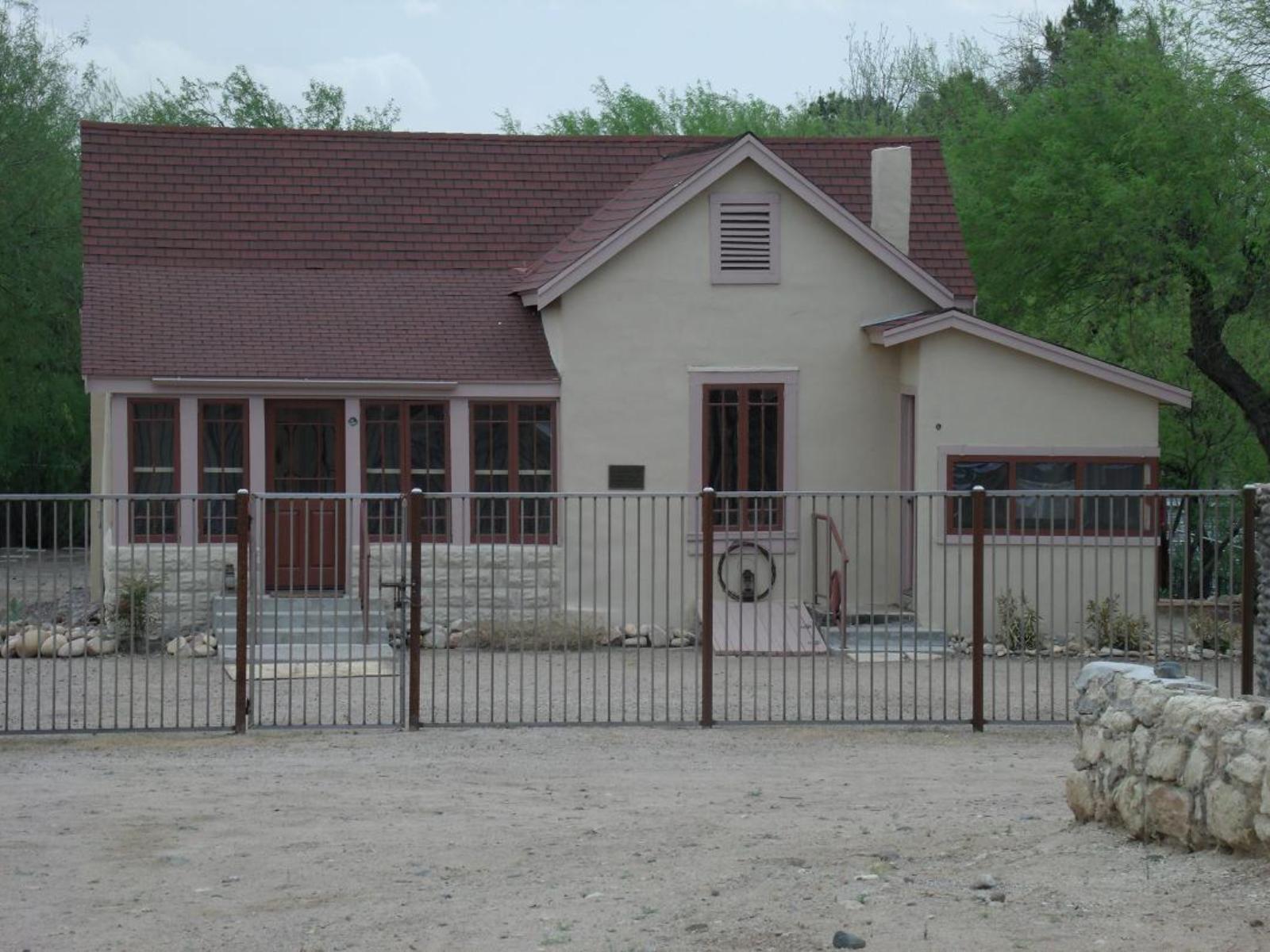
Why are people willing to pay so much to live here? What’s special about it?
Wickenburg attracts buyers seeking authentic Old West charm combined with modern amenities and desert beauty. The town offers guest ranches, Western-themed events, and historic downtown while providing access to outdoor recreation and scenic desert landscapes. Retirees and second-home buyers value the small-town atmosphere, clear skies, and mild winter weather that make it a popular escape destination.
Unlike suburban developments, Wickenburg maintains its frontier character with adobe architecture, local shops, and cultural events that celebrate Arizona’s Western heritage. The area’s gold mining history and preserved downtown create unique appeal for those wanting authentic Southwest living. Proximity to wilderness areas and the Hassayampa River provides recreational opportunities rare in the desert.
How Wickenburg Rose to Prominence
Wickenburg’s prominence began in 1863 when German prospector Henry Wickenburg discovered gold in the nearby Vulture Mountains, establishing one of Arizona’s richest gold mines. The town became a major supply center for miners and ranchers, earning the nickname “Gold Rush Town of the Desert.” The Vulture Mine produced millions of dollars in gold, making Wickenburg one of Arizona Territory’s most important settlements.
After the mining boom ended, Wickenburg evolved into a ranching center and later a guest ranch destination that attracted wealthy visitors seeking Western experiences. The development of dude ranches in the early 20th century established the area’s reputation for hospitality and outdoor recreation. Today’s Wickenburg capitalizes on its authentic Western heritage while serving as a gateway to desert recreation and a haven for those seeking small-town character near Phoenix.
3 Interesting Tidbits
1. Gold Rush Legacy – The historic Vulture Mine produced over $30 million in gold during its peak operation, making it one of Arizona’s most successful mining ventures.
2. Jail Tree – The famous Jail Tree downtown served as the town’s holding cell, where prisoners were chained to the mesquite tree while awaiting trial.
3. Guest Ranch Capital – Wickenburg pioneered the guest ranch industry in Arizona, with several historic ranches still operating today and attracting visitors worldwide.
23. Cornville – 170% Home Price Increase Since 2010

- 2010: $196,531
- 2011: $177,545
- 2012: $191,255
- 2013: $225,251
- 2014: $246,459
- 2015: $266,169
- 2016: $286,932
- 2017: $296,181
- 2018: $313,643
- 2019: $340,901
- 2020: $367,085
- 2021: $454,581
- 2022: $533,523
- 2023: $505,554
- 2024: $528,907
- 2025: $530,959
Cornville demonstrates impressive 170% growth since 2010, showing steady appreciation with accelerated gains during the recent market surge. The community maintained consistent upward momentum through most periods, with values jumping significantly during 2021-2022 from $367,085 to over $533,000. Current median prices of $530,959 reflect the area’s emergence as a sought-after Verde Valley destination.
Why Cornville?

Why are people willing to pay so much to live here? What’s special about it?
Cornville attracts buyers seeking rural tranquility with stunning red rock views and proximity to Sedona’s amenities without the premium prices. The area offers large lots, custom homes, and agricultural opportunities while providing access to hiking, wine tasting, and outdoor recreation. Residents value the peaceful atmosphere, dark skies, and small-town community feeling in one of Arizona’s most scenic regions.
Unlike tourist-heavy Sedona, Cornville maintains its agricultural character with working ranches, vineyards, and open spaces that preserve the rural lifestyle. The area provides affordable access to the Verde Valley’s natural beauty, including Oak Creek and surrounding red rock formations. Limited commercial development helps maintain property values while preserving the area’s authentic rural character.
How Cornville Rose to Prominence
Cornville’s prominence began in the late 1800s as an agricultural settlement in the fertile Verde Valley, taking advantage of Oak Creek’s water supply for farming and ranching. Early settlers established fruit orchards, vegetable farms, and cattle operations that supplied nearby mining camps and frontier settlements. The community’s name reflects its early role as a corn-growing center in the valley’s agricultural economy.
The area remained primarily agricultural through most of the 20th century until Sedona’s growth as a tourist destination increased interest in the broader Verde Valley. Cornville began attracting residents seeking rural living with access to Sedona’s amenities, leading to the development of custom homes and small ranchettes. Today’s Cornville balances its farming heritage with residential growth, appealing to buyers who want authentic rural living in a spectacular natural setting.
3 Interesting Tidbits
1. Wine Country – Cornville anchors the Verde Valley wine region, with several award-winning wineries and vineyards taking advantage of the area’s unique terroir and elevation.
2. Page Springs – The nearby Page Springs area features natural springs and creek access, rare water features that enhance recreational opportunities and property values.
3. Dark Sky Community – Cornville maintains minimal light pollution, making it popular with astronomers and stargazers seeking clear night skies.
22. Greer – 9.5% increase since 2023

- 2010: N/A
- 2011: N/A
- 2012: N/A
- 2013: N/A
- 2014: N/A
- 2015: N/A
- 2016: N/A
- 2017: N/A
- 2018: N/A
- 2019: N/A
- 2020: N/A
- 2021: N/A
- 2022: N/A
- 2023: $504,097
- 2024: $543,253
- 2025: $551,953
Greer shows limited data availability with pricing information beginning only in 2023, but demonstrates steady appreciation in its short data window. Values increased from $504,097 in 2023 to $551,953 in July 2025, reflecting a 9.5% gain over two years. The current median price of $551,953 positions Greer among Arizona’s premium mountain communities despite limited historical comparison data.
Why Greer?
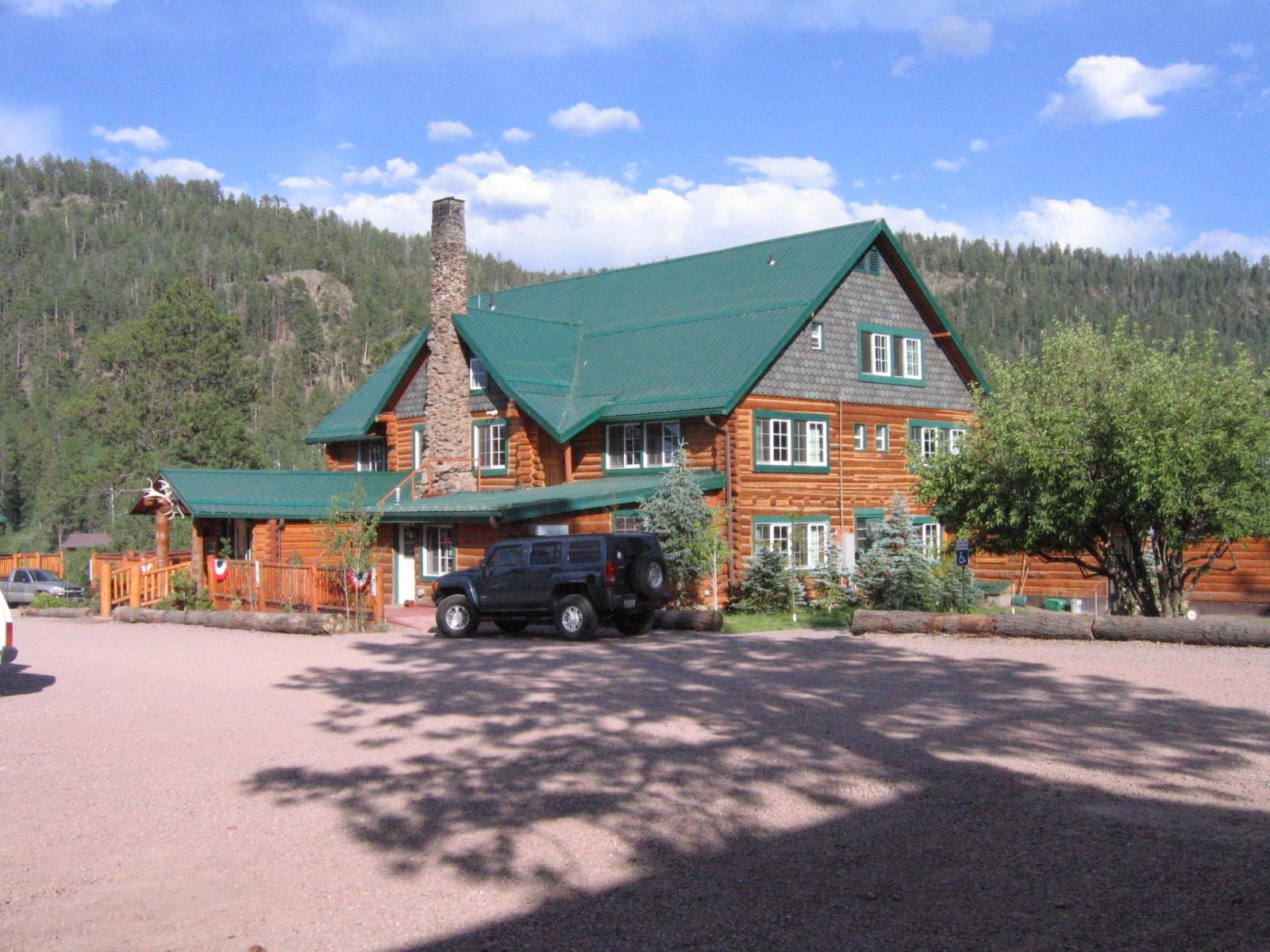
Why are people willing to pay so much to live here? What’s special about it?
Greer attracts buyers seeking true mountain living with four seasons, alpine forests, and year-round outdoor recreation opportunities. The village offers fishing, skiing, hiking, and wildlife viewing in a pristine mountain environment at over 8,000 feet elevation. Residents value the cool summers, snowy winters, and small-town atmosphere that provides an authentic mountain lifestyle unlike anywhere else in Arizona.
Unlike desert communities, Greer features pine and aspen forests, mountain lakes, and seasonal weather that attracts those seeking escape from Arizona’s heat. The area’s limited development and remote location preserve its natural character while providing access to activities like fly fishing and cross-country skiing. Cabins and mountain homes offer retreat-style living with modern amenities in a spectacular high-country setting.
How Greer Rose to Prominence
Greer’s prominence began in the 1870s when Mormon pioneers Willard and Thomas Greer established a settlement in the White Mountains, drawn by abundant water, timber, and grazing land. The community served as a supply center for logging operations and cattle ranching, taking advantage of the high elevation meadows for summer grazing. The natural beauty and cool climate made it a retreat destination even in its early days.
Throughout the 20th century, Greer evolved from a working ranch community into a mountain resort destination, attracting visitors seeking fishing, hunting, and alpine recreation. The development of cabins and lodges catered to Phoenix and Tucson residents escaping desert heat during summer months. Today’s Greer balances its frontier heritage with modern mountain living, offering authentic alpine experiences that command premium prices in Arizona’s limited mountain real estate market.
3 Interesting Tidbits
1. Highest Elevation – At over 8,000 feet elevation, Greer is one of Arizona’s highest year-round communities, providing true alpine climate and four distinct seasons.
2. Trout Waters – The area features several stocked trout streams and lakes, making it a premier fly fishing destination in the Southwest.
3. Historic Cabins – Many of the original log cabins and historic structures remain, preserving the area’s frontier character and mountain heritage.
21. Pinetop – 133% Home Price Increase Since 2010
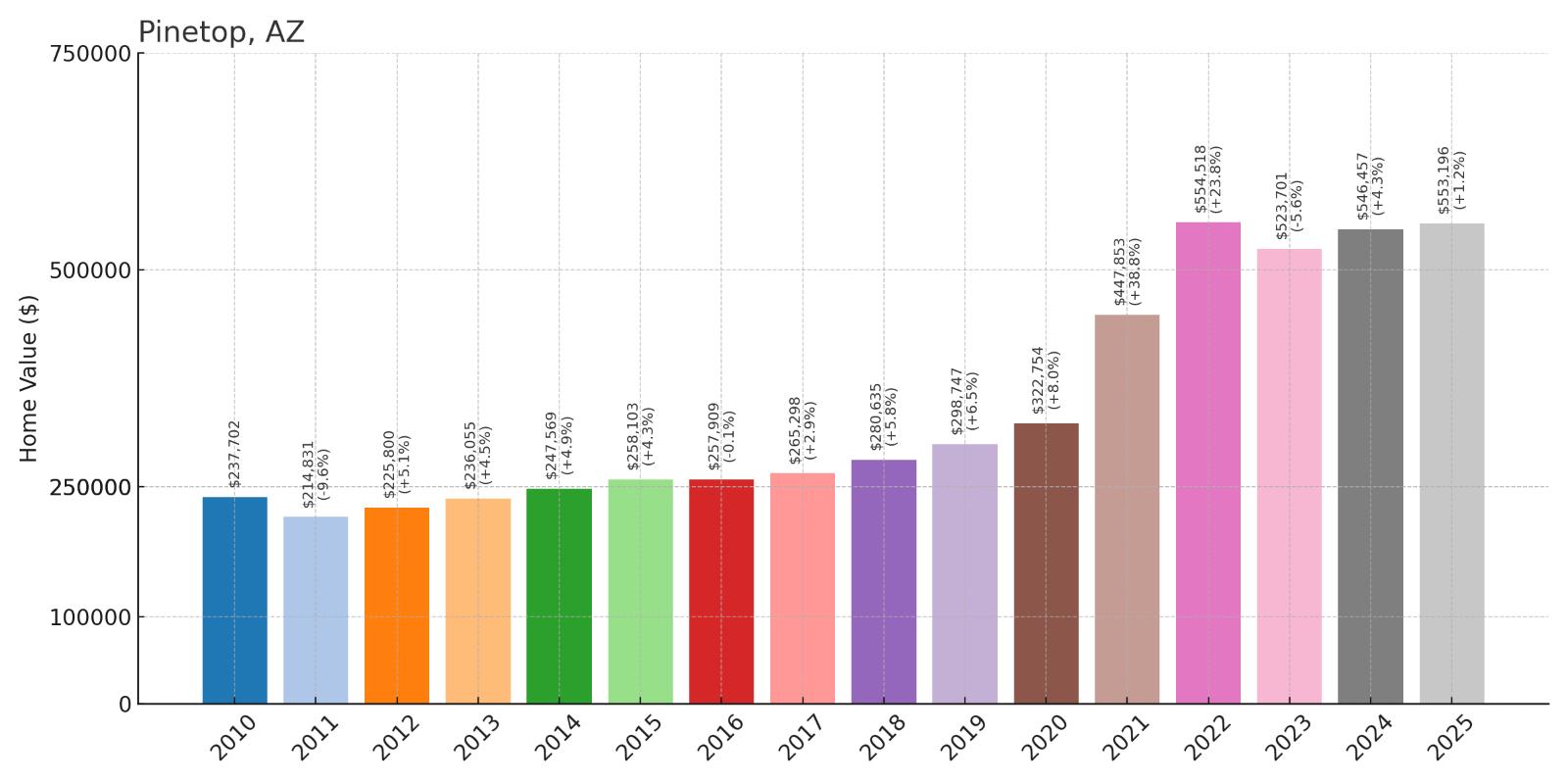
- 2010: $237,702
- 2011: $214,831
- 2012: $225,800
- 2013: $236,055
- 2014: $247,569
- 2015: $258,103
- 2016: $257,909
- 2017: $265,298
- 2018: $280,635
- 2019: $298,747
- 2020: $322,754
- 2021: $447,853
- 2022: $554,518
- 2023: $523,701
- 2024: $546,457
- 2025: $553,196
Pinetop achieved solid 133% growth since 2010, showing steady appreciation with a dramatic surge during the pandemic period. The community experienced consistent but moderate gains through most of the decade before accelerating significantly during 2020-2022, when values jumped from $322,754 to over $554,000. Current median prices of $553,196 reflect sustained demand for this established White Mountains community.
Why Pinetop?

Why are people willing to pay so much to live here? What’s special about it?
Pinetop attracts buyers seeking mountain living with four seasons, pine forests, and year-round recreational opportunities at a more accessible price point than other mountain communities. The area offers hiking, fishing, skiing, and cool summer weather that provides relief from desert heat. Families and retirees value the small-town atmosphere, outdoor lifestyle, and proximity to wilderness areas while maintaining reasonable access to urban amenities.
Unlike lower elevation communities, Pinetop provides true mountain living with seasonal snow, autumn colors, and forest surroundings. The area appeals to those wanting authentic Arizona high country experiences without the isolation of more remote locations. Golf courses, restaurants, and shopping provide modern conveniences while maintaining the mountain town character that drives property values.
How Pinetop Rose to Prominence
Pinetop’s prominence began in the late 1800s as a lumber and ranching center in the White Mountains, taking advantage of the area’s vast pine forests and high elevation meadows. The community served as a supply point for logging operations and provided summer grazing for cattle from lower elevation ranches. The cool climate and natural beauty attracted early visitors seeking escape from Arizona’s desert heat.
The transition to a resort community began in the mid-20th century when improved roads made the area more accessible to Phoenix and Tucson residents. The development of cabins, lodges, and recreational facilities transformed Pinetop from a working mountain town into a destination for summer homes and outdoor recreation. Today’s Pinetop successfully balances its logging heritage with tourism and residential development, creating a mountain lifestyle that appeals to buyers throughout Arizona.
3 Interesting Tidbits
1. Logging Heritage – Historic sawmill sites and logging equipment throughout the area reflect Pinetop’s role in Arizona’s timber industry during the territorial period.
2. Cool Summers – Summer temperatures rarely exceed 80 degrees, making Pinetop a popular escape destination for desert residents during the hottest months.
3. Wildlife Corridor – The area serves as a critical wildlife corridor for elk, deer, and other mountain species, providing exceptional viewing opportunities for residents.
20. Elgin – 91% Home Price Increase Since 2010
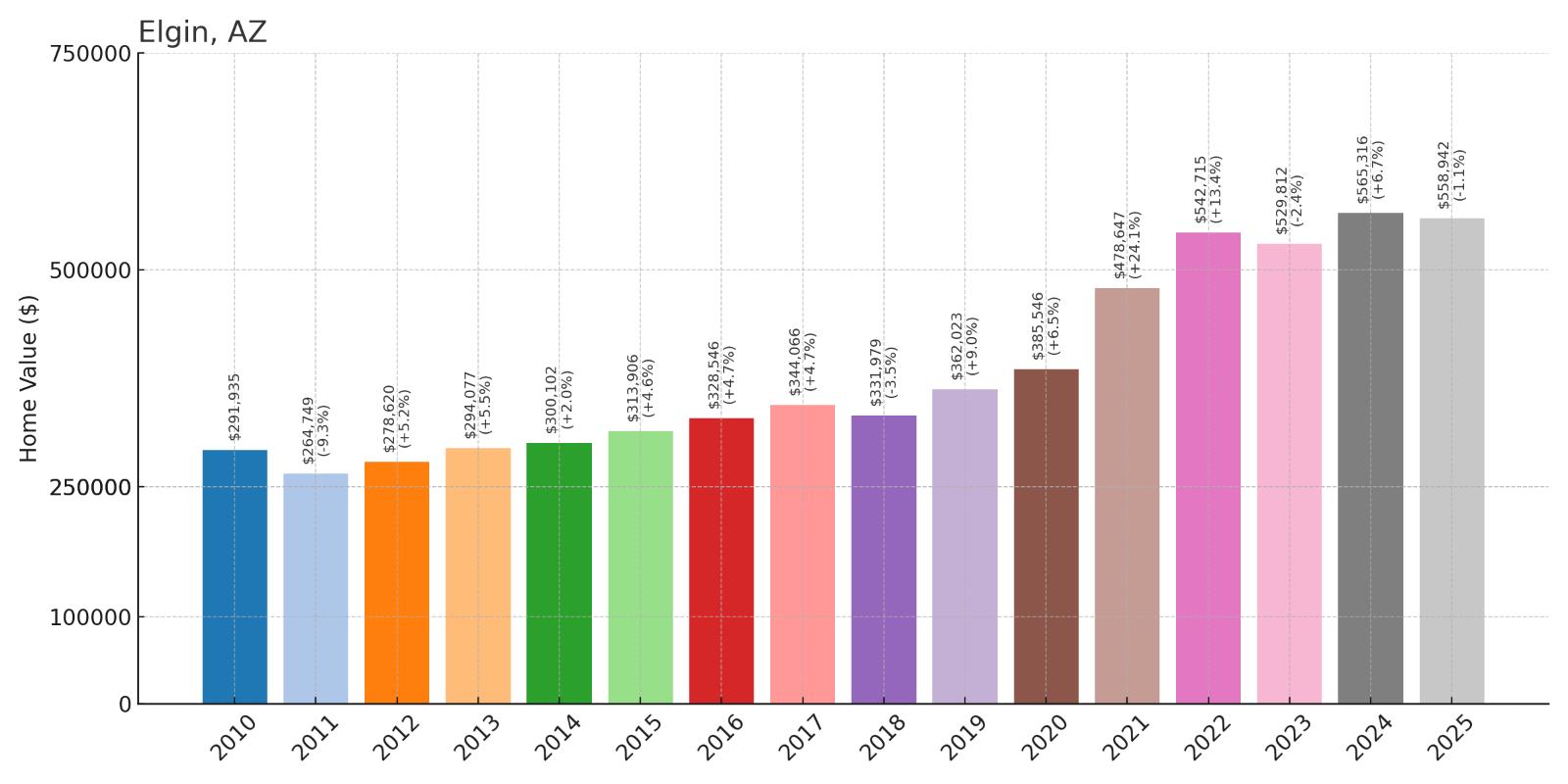
- 2010: $291,935
- 2011: $264,749
- 2012: $278,620
- 2013: $294,077
- 2014: $300,102
- 2015: $313,906
- 2016: $328,546
- 2017: $344,066
- 2018: $331,979
- 2019: $362,023
- 2020: $385,546
- 2021: $478,647
- 2022: $542,715
- 2023: $529,812
- 2024: $565,316
- 2025: $558,942
Elgin shows moderate but steady 91% appreciation since 2010, starting from a higher baseline than many communities and maintaining consistent growth. The area experienced gradual increases through most periods before accelerating during 2020-2022, when values rose from $385,546 to over $542,000. Current median prices of $558,942 reflect the premium nature of this wine country location in southern Arizona.
Why Elgin?
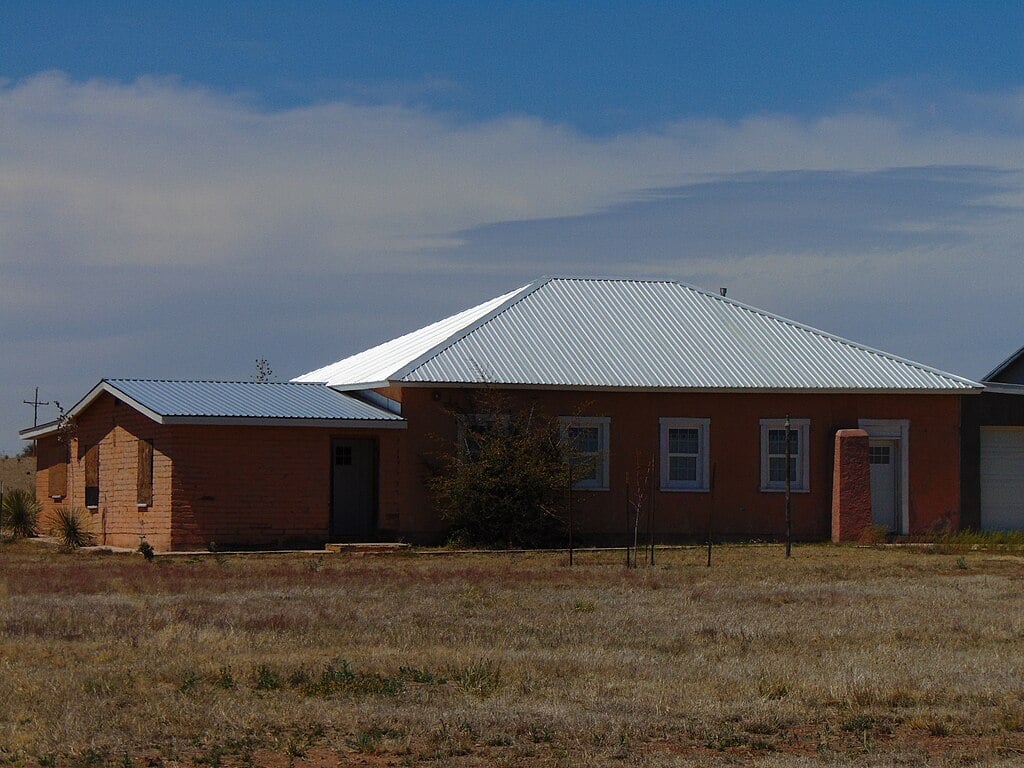
Why are people willing to pay so much to live here? What’s special about it?
Elgin attracts buyers seeking wine country living with panoramic views, rural tranquility, and proximity to Tucson’s amenities. The area offers vineyard properties, custom homes on large lots, and access to award-winning wineries and restaurants. Residents value the cooler temperatures, dark skies, and agricultural lifestyle while enjoying the cultural attractions of Arizona’s premier wine region.
Unlike suburban developments, Elgin maintains its rural character with working vineyards, horse properties, and open spaces that preserve the agricultural heritage. The area’s elevation provides relief from desert heat while offering spectacular views of surrounding mountain ranges. Limited development and strict zoning help maintain property values while preserving the wine country atmosphere that attracts affluent buyers.
How Elgin Rose to Prominence
Elgin’s prominence began in the 1880s as a ranching and mining supply center in the Sonoita Valley, taking advantage of the area’s grasslands and water sources for cattle operations. The community served nearby mining camps and provided a commercial center for the region’s agricultural activities. The high elevation and favorable climate made it attractive for both ranching and early agricultural experiments.
The transformation to wine country began in the 1970s when pioneering vintners recognized the area’s potential for grape growing, with its elevation, soil conditions, and climate similar to successful wine regions. The establishment of several wineries in the 1980s and 1990s created Arizona’s first recognized wine appellation. Today’s Elgin capitalizes on its wine country reputation while maintaining its ranching heritage, attracting buyers seeking rural luxury in a unique agricultural setting.
3 Interesting Tidbits
1. Wine Appellation – Elgin anchors the Sonoita AVA (American Viticultural Area), Arizona’s first federally recognized wine region established in 1984.
2. Sky Island – The area’s elevation creates a unique “sky island” ecosystem with cooler temperatures and different vegetation than surrounding desert areas.
3. Historic Ranch – Several historic cattle ranches continue operating, maintaining the area’s Western heritage alongside modern wine production.
19. Forest Lakes – 128% Home Price Increase Since 2010
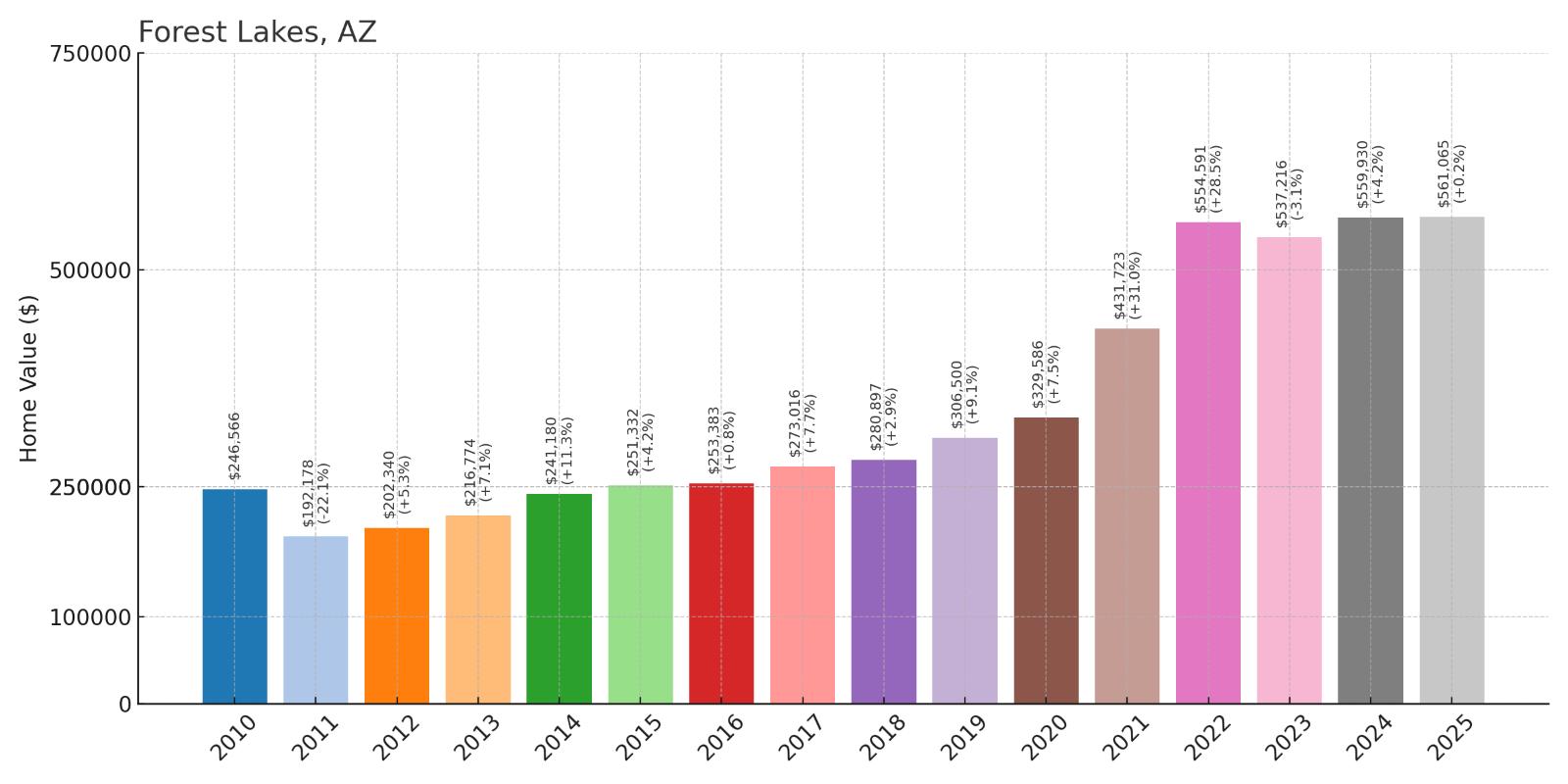
- 2010: $246,566
- 2011: $192,178
- 2012: $202,340
- 2013: $216,774
- 2014: $241,180
- 2015: $251,332
- 2016: $253,383
- 2017: $273,016
- 2018: $280,897
- 2019: $306,500
- 2020: $329,586
- 2021: $431,723
- 2022: $554,591
- 2023: $537,216
- 2024: $559,930
- 2025: $561,065
Forest Lakes demonstrates strong 128% growth since 2010, recovering dramatically from its 2011 low of $192,178 to current values exceeding $561,000. The community showed steady appreciation through most periods before accelerating significantly during 2020-2022, when values jumped from $329,586 to over $554,000. July 2025 prices of $561,065 reflect sustained demand for this mountain lake community.
Why Forest Lakes?

Why are people willing to pay so much to live here? What’s special about it?
Forest Lakes attracts buyers seeking mountain living with actual lakes, four seasons, and pristine forest surroundings in the White Mountains. The community offers fishing, boating, hiking, and wildlife viewing while providing cooler temperatures and seasonal weather changes. Residents value the private lakes, custom cabins, and resort-like atmosphere that creates a true mountain retreat experience.
Unlike most Arizona communities, Forest Lakes features actual bodies of water with fishing and recreational opportunities rare in the desert state. The area provides authentic mountain living with pine forests, seasonal snow, and elevation that offers relief from desert heat. Limited development and private lake access create exclusivity that drives premium property values in this unique setting.
How Forest Lakes Rose to Prominence
Forest Lakes’ prominence began as a planned mountain resort community developed in the 1960s to take advantage of the area’s natural lakes and forest setting in the White Mountains. Developers recognized the unique appeal of actual lakes in Arizona’s mountain region and created a residential community around recreational amenities. The private lakes and forest surroundings attracted buyers seeking mountain retreat properties.
The community evolved from a seasonal cabin destination into a year-round residential area as improved roads and utilities made permanent living more feasible. The preservation of the natural setting and private lake access helped maintain the exclusive character that attracted affluent buyers. Today’s Forest Lakes successfully balances development with environmental preservation, creating a unique mountain community that commands premium prices in Arizona’s limited lakefront market.
3 Interesting Tidbits
1. Private Lakes – Forest Lakes features several private lakes stocked with trout, providing exclusive fishing and boating opportunities for residents.
2. Elevation Benefits – At over 7,000 feet elevation, the area enjoys cool summers and snowy winters, offering true four-season mountain living.
3. Wildlife Sanctuary – The community serves as habitat for elk, deer, and numerous bird species, creating natural wildlife viewing opportunities.
18. Anthem – 181% Home Price Increase Since 2010
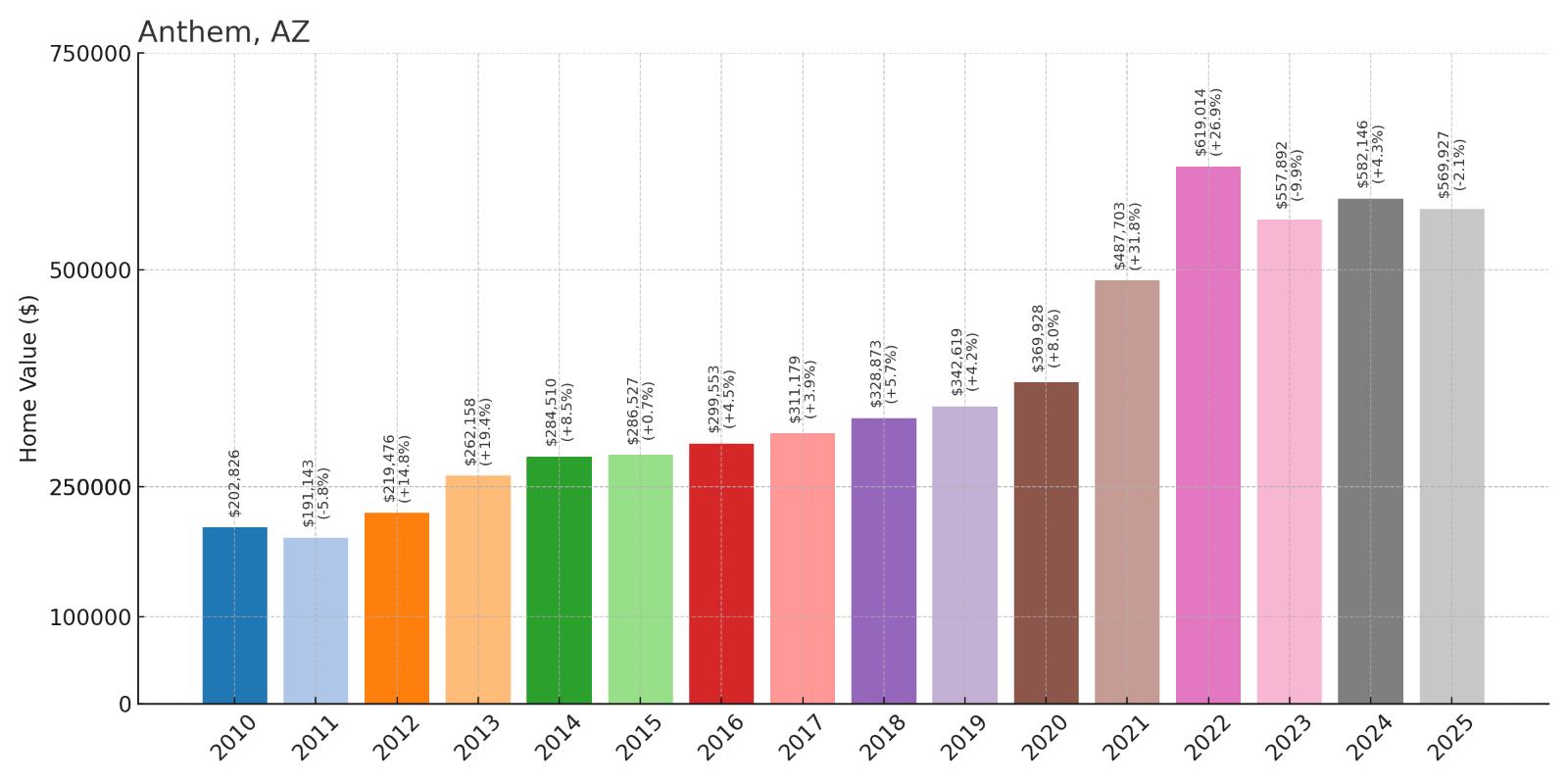
- 2010: $202,826
- 2011: $191,143
- 2012: $219,476
- 2013: $262,158
- 2014: $284,510
- 2015: $286,527
- 2016: $299,553
- 2017: $311,179
- 2018: $328,873
- 2019: $342,619
- 2020: $369,928
- 2021: $487,703
- 2022: $619,014
- 2023: $557,892
- 2024: $582,146
- 2025: $569,927
Anthem achieved impressive 181% growth since 2010, showing strong recovery from early market challenges and sustained appreciation through the decade. The community experienced particularly robust gains during 2012-2014 and again during the pandemic surge of 2020-2022, when values jumped from $369,928 to over $619,000. Current median prices of $569,927 reflect the premium nature of this master-planned North Phoenix community.
Why Anthem?
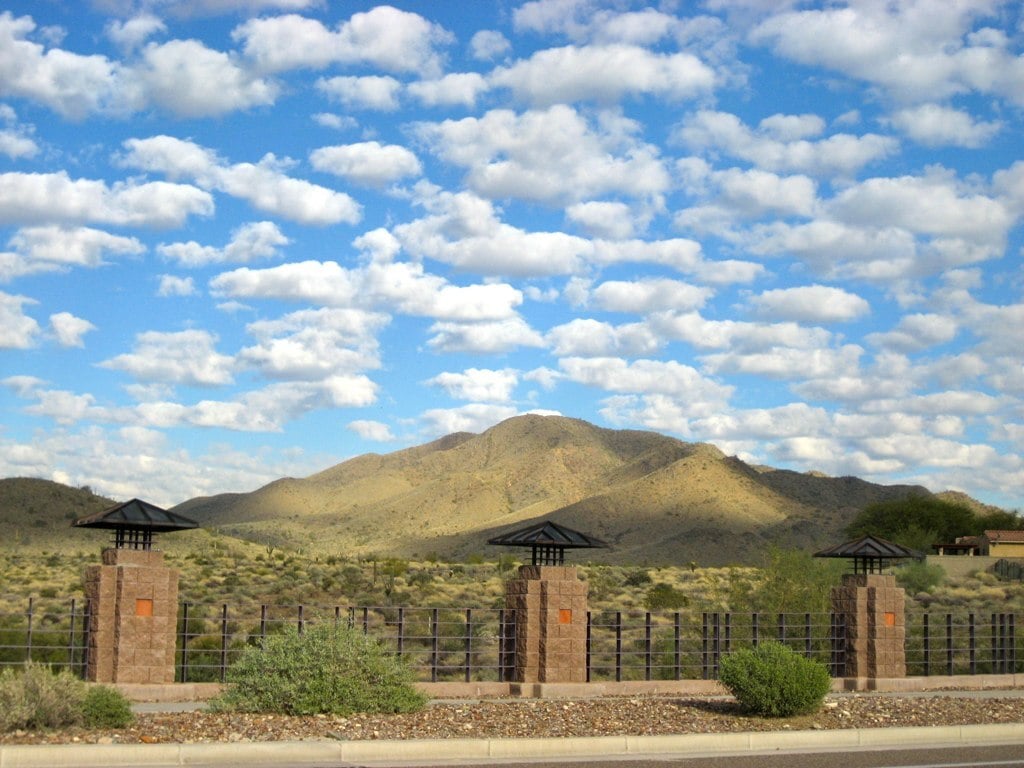
Why are people willing to pay so much to live here? What’s special about it?
Anthem attracts buyers seeking master-planned community living with resort-style amenities, golf courses, and stunning desert mountain views. The area offers new construction, planned neighborhoods, and extensive recreational facilities while maintaining proximity to Phoenix employment centers. Families value the excellent schools, community centers, and organized activities that create a strong sense of neighborhood identity.
Unlike older suburbs, Anthem features modern infrastructure, planned open spaces, and architectural standards that maintain property values and community character. The area’s elevation provides cooler temperatures and dramatic views of the surrounding desert landscape. Golf courses, hiking trails, and community amenities create a resort lifestyle that appeals to both young families and active retirees.
How Anthem Rose to Prominence
Anthem’s prominence began in the 1990s as a master-planned community developed by Del Webb on former ranch land north of Phoenix, designed to capture the growing demand for planned suburban living. The development incorporated golf courses, community centers, and desert preservation areas to create a comprehensive lifestyle community. The project represented a new model for Arizona residential development that balanced growth with natural preservation.
The community’s success attracted additional residential and commercial development, transforming the area from open desert into a major suburban center. Anthem’s planned approach to development, including deed restrictions and architectural guidelines, helped maintain property values and community standards. Today’s Anthem serves as a model for master-planned communities, offering suburban amenities with desert beauty that attracts buyers willing to pay premium prices for planned community living.
3 Interesting Tidbits
1. Master Planning – Anthem was one of Arizona’s first major master-planned communities, setting standards for integrated residential and recreational development.
2. Desert Preservation – The community preserved thousands of acres of natural desert, creating hiking trails and open space that enhance property values.
3. Community Center – The Anthem Community Center features pools, fitness facilities, and programming that rival expensive private clubs.
17. Gilbert – 179% Home Price Increase Since 2010

- 2010: $205,228
- 2011: $180,978
- 2012: $201,811
- 2013: $251,456
- 2014: $273,928
- 2015: $280,970
- 2016: $297,142
- 2017: $312,294
- 2018: $336,110
- 2019: $355,956
- 2020: $387,900
- 2021: $498,575
- 2022: $622,857
- 2023: $561,380
- 2024: $590,194
- 2025: $573,168
Gilbert achieved exceptional 179% growth since 2010, demonstrating remarkable resilience and sustained appreciation throughout the period. The town showed particularly strong performance during 2012-2014 and the pandemic surge of 2020-2022, when values jumped from $387,900 to over $622,000. Current median prices of $573,168 reflect the premium status of this consistently top-rated East Valley community.
Why Gilbert?
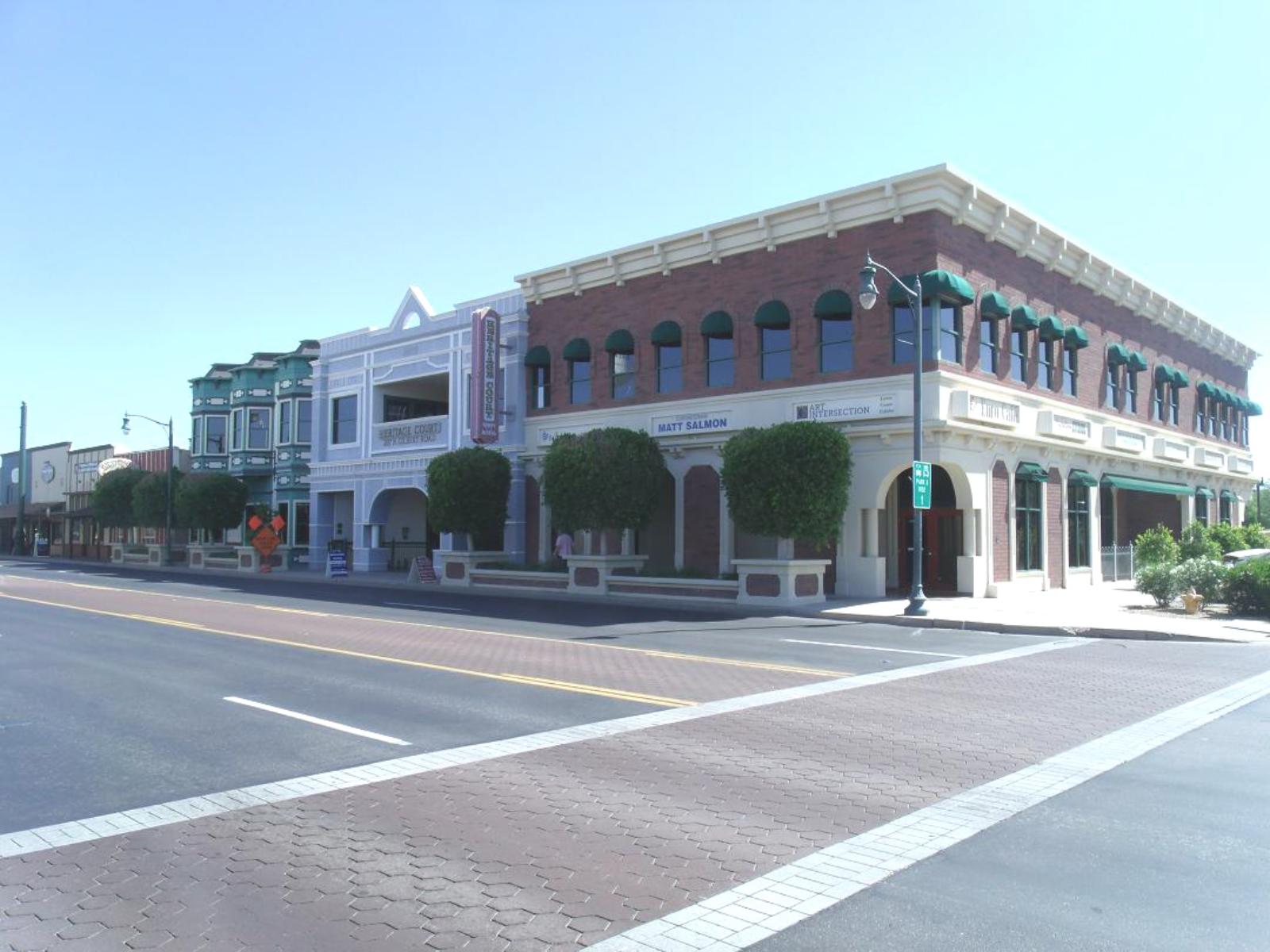
Why are people willing to pay so much to live here? What’s special about it?
Gilbert attracts buyers seeking exceptional schools, family-friendly neighborhoods, and small-town atmosphere within a major metropolitan area. The town offers safe communities, excellent municipal services, and strong property values while maintaining manageable growth and traffic. Families value the top-rated schools, recreational programs, and community events that create an ideal environment for raising children.
Unlike larger cities, Gilbert maintains its small-town character with historic downtown, community festivals, and neighborhood feel despite substantial growth. The town’s careful planning and high municipal standards create an environment that consistently ranks among Arizona’s best places to live. Master-planned communities and golf courses provide resort-style amenities that enhance the family-oriented lifestyle.
How Gilbert Rose to Prominence
Gilbert’s prominence began in 1902 when William Gilbert established the town as an agricultural center in the Salt River Valley, focusing on cotton, citrus, and dairy farming. The community remained primarily agricultural through most of the 20th century, developing a reputation for rural values and close-knit community life. The irrigation infrastructure and fertile soil made it one of Arizona’s most productive farming areas.
The transformation to a major suburban center began in the 1980s when Phoenix’s growth reached the East Valley, with Gilbert offering available land and pro-development policies. The town’s commitment to excellent schools and municipal services attracted young families seeking suburban amenities with small-town values. Today’s Gilbert successfully balances rapid growth with community character, creating a family-oriented environment that commands premium real estate prices.
3 Interesting Tidbits
1. Water Tower – The historic Gilbert Water Tower downtown serves as a landmark and symbol of the town’s agricultural heritage and community pride.
2. School Excellence – Gilbert consistently ranks among Arizona’s top school districts, with several schools receiving national recognition for academic achievement.
3. Heritage Festival – The annual Gilbert Days celebration honors the town’s agricultural heritage and maintains community traditions despite rapid growth.
16. Sonoita – 96% Home Price Increase Since 2010
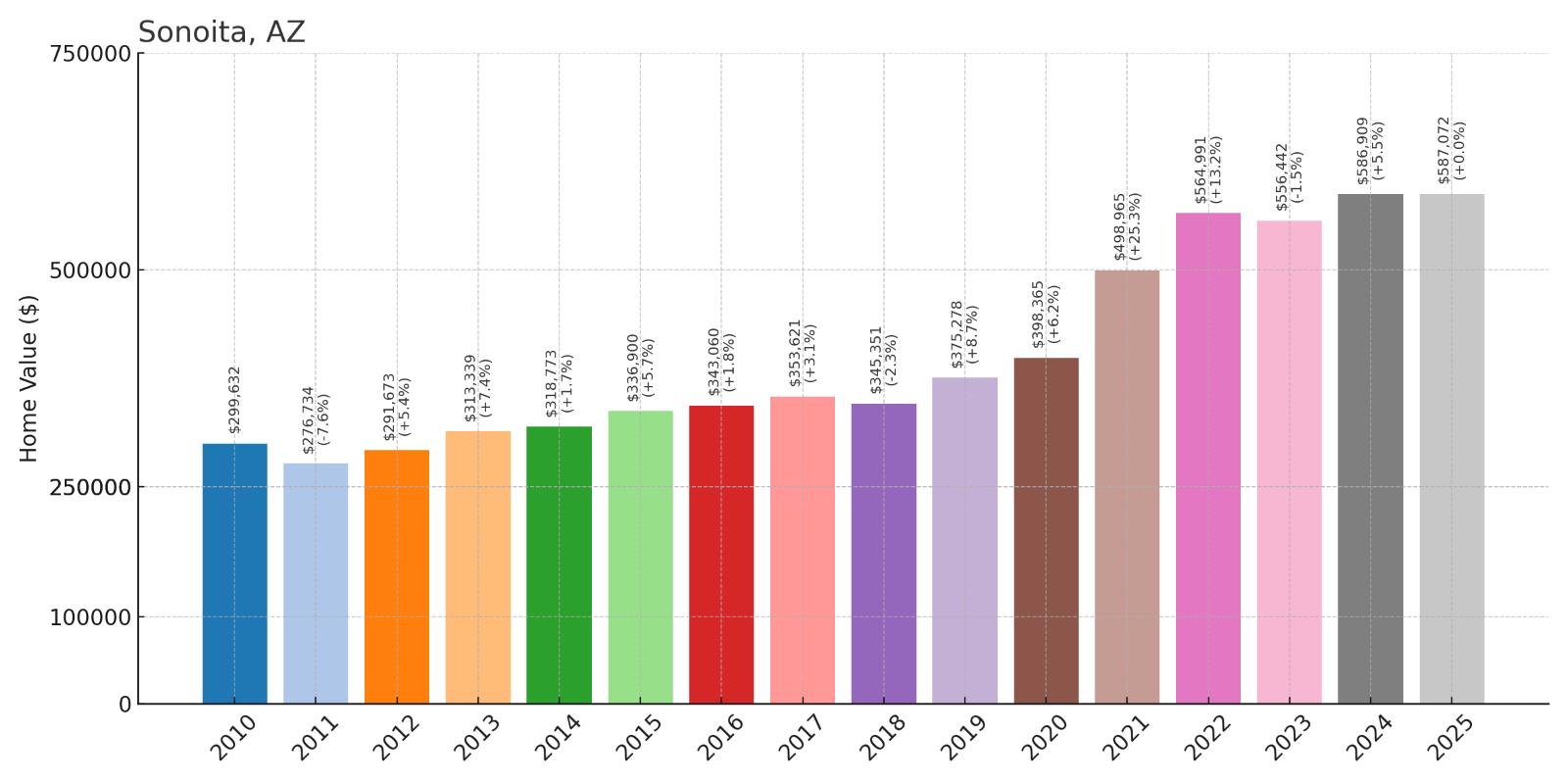
- 2010: $299,632
- 2011: $276,734
- 2012: $291,673
- 2013: $313,339
- 2014: $318,773
- 2015: $336,900
- 2016: $343,060
- 2017: $353,621
- 2018: $345,351
- 2019: $375,278
- 2020: $398,365
- 2021: $498,965
- 2022: $564,991
- 2023: $556,442
- 2024: $586,909
- 2025: $587,072
Sonoita shows solid 96% appreciation since 2010, starting from a higher baseline and maintaining steady growth throughout most periods. The community experienced consistent but moderate gains before accelerating during 2020-2022, when values rose from $398,365 to nearly $565,000. Current median prices of $587,072 reflect the premium nature of this wine country and ranching community in southern Arizona.
Why Sonoita?

Why are people willing to pay so much to live here? What’s special about it?
Sonoita attracts buyers seeking wine country living with spectacular views, rural tranquility, and proximity to both Tucson and the Mexican border. The area offers vineyard properties, working ranches, and custom homes on large parcels while providing access to award-winning wineries and outdoor recreation. Residents value the cooler temperatures, dark skies, and agricultural lifestyle in one of Arizona’s most scenic wine regions.
Unlike suburban developments, Sonoita maintains its ranching and agricultural character with working cattle operations, vineyards, and open grasslands that preserve the rural atmosphere. The area’s elevation provides relief from desert heat while offering panoramic views of surrounding mountain ranges. Limited development and large lot sizes help maintain property values while preserving the wine country lifestyle that attracts affluent buyers.
How Sonoita Rose to Prominence
Sonoita’s prominence began in the 1880s as a ranching and mining supply center in the high grasslands of southern Arizona, taking advantage of the area’s favorable climate and water sources for cattle operations. The community served as a commercial hub for surrounding ranches and provided supplies to nearby mining camps in the Santa Rita Mountains. The railroad connection enhanced its role as a regional trade center.
The transition to wine country began in the 1970s when pioneering vintners recognized the area’s potential for grape growing, with elevation, climate, and soil conditions favorable for wine production. The establishment of several wineries created Arizona’s premier wine region and attracted buyers seeking rural properties with wine country appeal. Today’s Sonoita successfully balances its ranching heritage with wine production, creating a unique lifestyle that commands premium real estate prices.
3 Interesting Tidbits
1. Wine Heritage – Sonoita is home to some of Arizona’s oldest and most award-winning wineries, establishing the state’s reputation for quality wine production.
2. Grassland Ecosystem – The area features rare high-elevation grasslands that support both cattle ranching and unique wildlife viewing opportunities.
3. Historic Railroad – The old railroad grade through town reflects Sonoita’s role as a transportation hub during Arizona’s territorial and early statehood periods.
15. Munds Park – 176% Home Price Increase Since 2010

- 2010: $217,982
- 2011: $189,552
- 2012: $201,816
- 2013: $221,288
- 2014: $237,126
- 2015: $251,802
- 2016: $268,369
- 2017: $286,920
- 2018: $306,900
- 2019: $330,886
- 2020: $350,178
- 2021: $483,959
- 2022: $615,309
- 2023: $588,125
- 2024: $596,270
- 2025: $600,600
Munds Park demonstrates excellent 176% growth since 2010, showing consistent appreciation with a dramatic acceleration during the pandemic period. The community experienced steady gains through most of the decade before surging during 2020-2022, when values jumped from $350,178 to over $615,000. Current median prices of $600,600 reflect strong demand for this forested mountain community between Phoenix and Flagstaff.
Why Munds Park?

Why are people willing to pay so much to live here? What’s special about it?
Munds Park attracts buyers seeking mountain living with four seasons, pine forests, and proximity to both Phoenix and Flagstaff amenities. The area offers cooler temperatures, seasonal weather changes, and outdoor recreation opportunities while providing reasonable access to urban employment and services. Residents value the small-town atmosphere, natural beauty, and mountain lifestyle that provides escape from desert heat.
Unlike desert communities, Munds Park features true mountain living with pine forests, seasonal snow, and elevation that offers year-round outdoor activities. The area provides authentic mountain experiences while maintaining connectivity to major metropolitan areas through Interstate 17. Limited development and forest surroundings help preserve the natural character that drives premium property values.
How Munds Park Rose to Prominence
Munds Park’s prominence began in the early 1900s as a lumber camp and railroad stop on the line connecting Phoenix to Flagstaff, taking advantage of the area’s vast pine forests for timber operations. The community served as a supply center for logging activities and provided lodging for travelers making the journey between Arizona’s major cities. The natural setting and cooler climate attracted early visitors seeking mountain recreation.
The transition to a residential community began in the mid-20th century when improved highways made the area more accessible to Phoenix residents seeking mountain retreats. The development of cabins and recreational facilities transformed Munds Park from a working lumber town into a destination for second homes and mountain living. Today’s Munds Park successfully balances its logging heritage with residential development, creating a mountain community that attracts buyers seeking authentic high-country living.
3 Interesting Tidbits
1. Railroad Heritage – Historic railroad structures and equipment reflect Munds Park’s role as a key stop on the Phoenix-Flagstaff rail line during the early 1900s.
2. Lumber Legacy – Old sawmill sites and logging roads throughout the area preserve the community’s history as a major timber center in northern Arizona.
3. Gateway Location – Munds Park serves as a gateway to both the high country and desert regions, offering access to diverse recreational opportunities.
14. Prescott – 146% Home Price Increase Since 2010
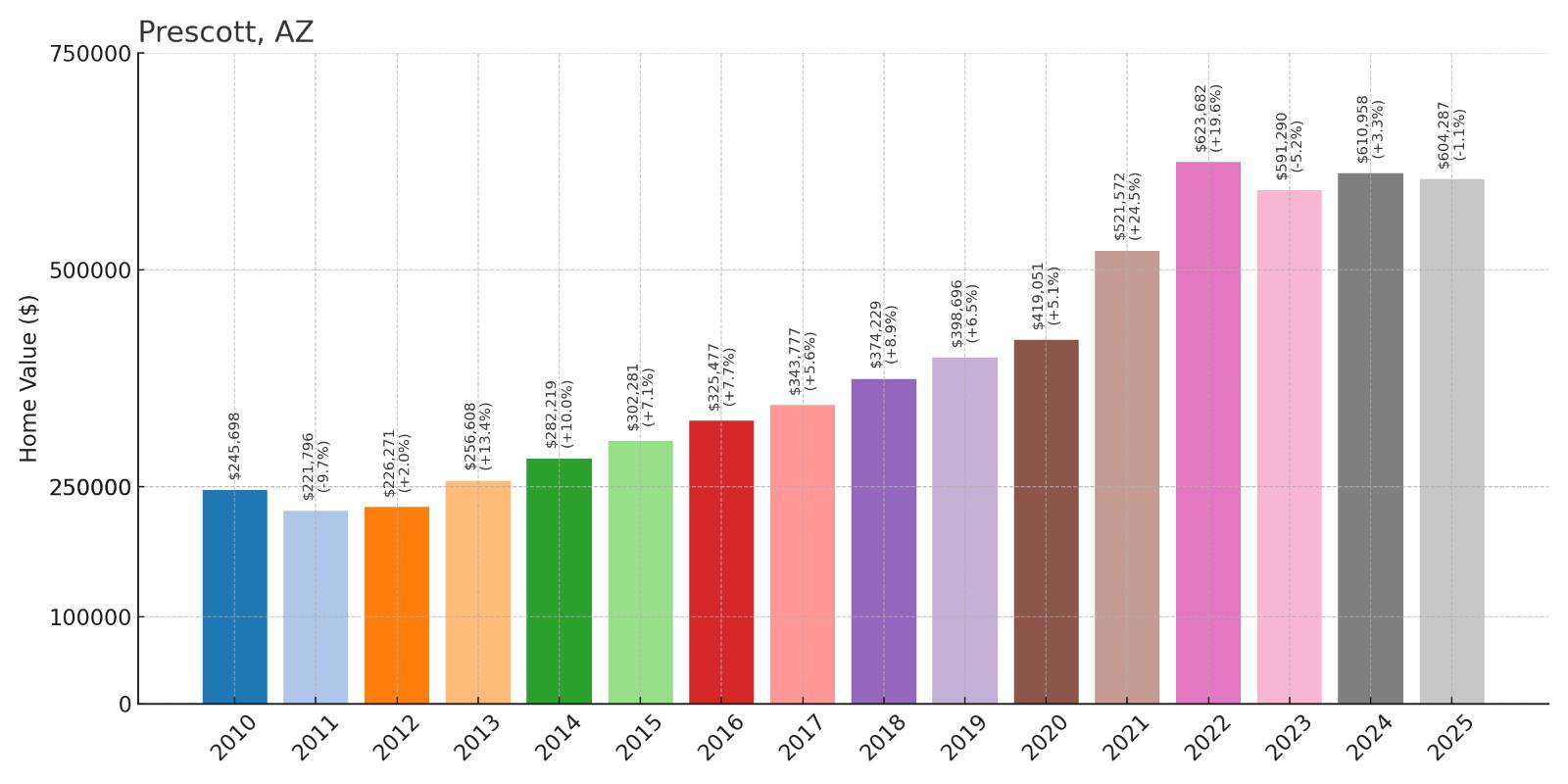
- 2010: $245,698
- 2011: $221,796
- 2012: $226,271
- 2013: $256,608
- 2014: $282,219
- 2015: $302,281
- 2016: $325,477
- 2017: $343,777
- 2018: $374,229
- 2019: $398,696
- 2020: $419,051
- 2021: $521,572
- 2022: $623,682
- 2023: $591,290
- 2024: $610,958
- 2025: $604,287
Prescott achieved solid 146% growth since 2010, showing consistent appreciation with particularly strong performance during the recent market surge. The city experienced steady gains through most periods before accelerating during 2020-2022, when values jumped from $419,051 to over $623,000. Current median prices of $604,287 reflect the premium status of this historic Arizona city and popular retirement destination.
Why Prescott?

Why are people willing to pay so much to live here? What’s special about it?
Prescott attracts buyers seeking four-season living with historic charm, cultural amenities, and mountain beauty at a more temperate elevation. The city offers cooler summers, mild winters, and a vibrant downtown with galleries, restaurants, and events while maintaining proximity to Phoenix. Retirees and families value the excellent healthcare, educational opportunities, and outdoor recreation that create an ideal balance of urban sophistication and mountain lifestyle.
Unlike desert cities, Prescott features pine forests, seasonal weather changes, and elevation that provides relief from extreme heat while offering year-round outdoor activities. The city’s Victorian architecture, historic courthouse square, and cultural events create character and charm rare in newer Arizona communities. Golf courses, hiking trails, and nearby wilderness areas enhance the lifestyle appeal that justifies premium property values.
How Prescott Rose to Prominence
Prescott’s prominence began in 1864 when it was established as Arizona Territory’s first capital, chosen for its moderate climate and strategic location in the central mountains. The discovery of gold in the nearby Bradshaw Mountains attracted miners and businesses, while the territorial government brought political importance and economic stability. The city served as the territorial capital until 1867 and again from 1877 to 1889.
After losing its capital status, Prescott evolved into a ranching and mining center, then gradually into a retirement and tourism destination as Arizona’s population grew. The preservation of historic buildings and the development of cultural amenities attracted retirees seeking small-city charm with urban conveniences. Today’s Prescott successfully balances its frontier heritage with modern amenities, creating a lifestyle that attracts buyers willing to pay premium prices for historic character and mountain living.
3 Interesting Tidbits
1. Territorial Capital – Prescott served as Arizona Territory’s capital and retains many historic government buildings from the 1860s territorial period.
2. Whiskey Row – The famous Whiskey Row downtown features historic saloons and buildings that preserve the Old West atmosphere and attract visitors nationwide.
3. Courthouse Plaza – The historic courthouse square serves as the heart of community life, hosting festivals, concerts, and events that maintain small-town character.
13. Parks – 158% Home Price Increase Since 2010

- 2010: $241,197
- 2011: $213,787
- 2012: $211,816
- 2013: $211,032
- 2014: $245,685
- 2015: $273,292
- 2016: $285,789
- 2017: $314,130
- 2018: $340,474
- 2019: $367,478
- 2020: $386,662
- 2021: $491,364
- 2022: $605,308
- 2023: $588,044
- 2024: $608,413
- 2025: $623,421
Parks demonstrates strong 158% growth since 2010, showing remarkable recovery from early market lows and sustained appreciation through the decade. The community experienced particularly robust gains during 2014-2019 and again during the pandemic surge of 2020-2022, when values jumped from $386,662 to over $605,000. Current median prices of $623,421 reflect growing demand for this forested community near Flagstaff.
Why Parks?
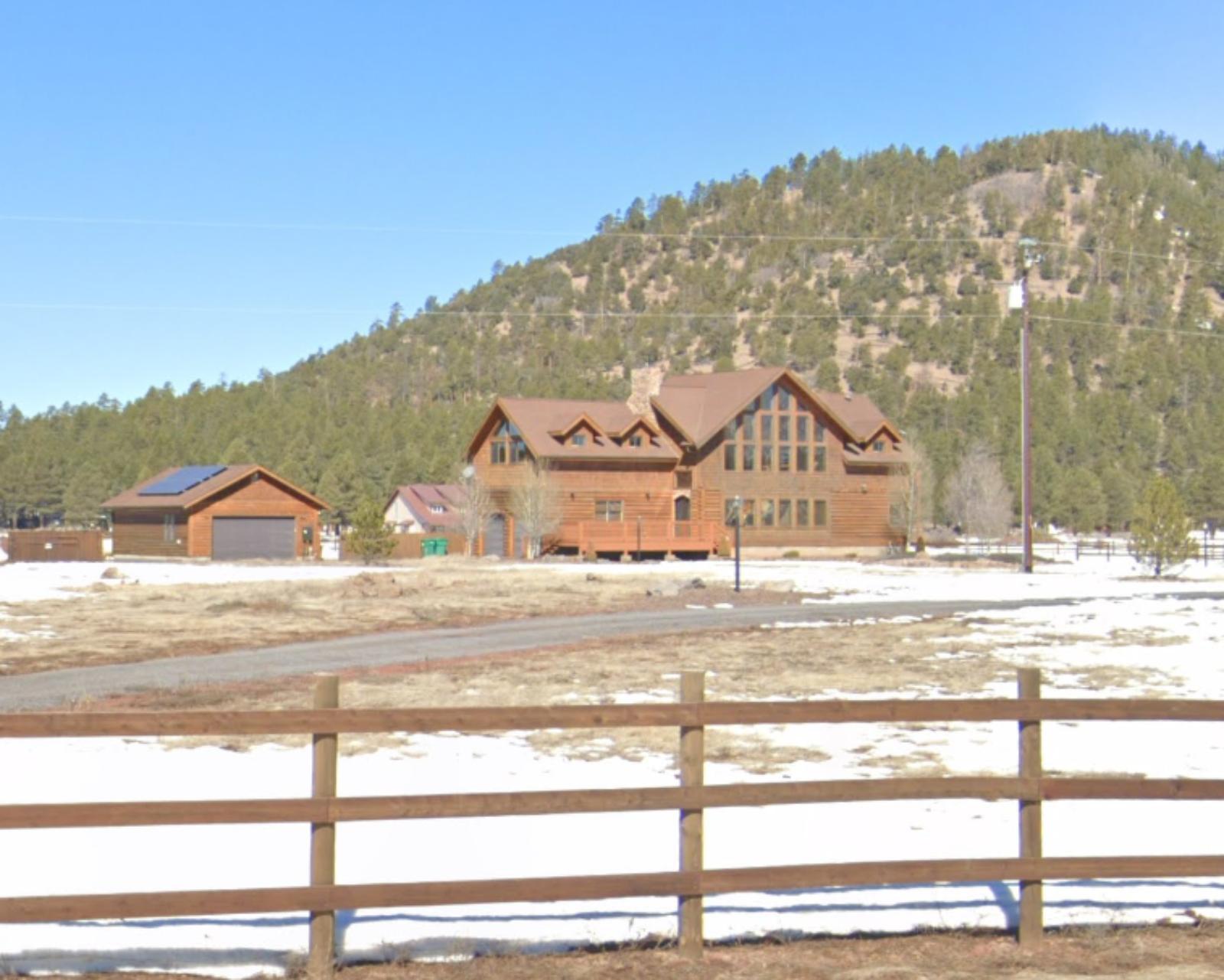
Why are people willing to pay so much to live here? What’s special about it?
Parks attracts buyers seeking mountain living with four seasons, pine forests, and proximity to Flagstaff’s amenities at more affordable prices than the city itself. The area offers larger lots, custom homes, and rural atmosphere while providing access to Northern Arizona University and outdoor recreation opportunities. Residents value the cooler climate, natural beauty, and small-town feel that offers escape from urban congestion.
Unlike urban areas, Parks maintains its rural character with forest surroundings, wildlife viewing opportunities, and space for horses and outdoor activities. The community provides authentic mountain living with seasonal snow and temperature changes that appeal to those seeking four-season experiences. Limited development and forest preservation help maintain the natural setting that drives property values in this high-country location.
How Parks Rose to Prominence
Parks’ prominence began in the late 1800s as a ranching and lumber community in the pine forests south of Flagstaff, taking advantage of the area’s natural resources and transportation connections. The community served as a supply center for logging operations and cattle ranching, providing services for workers and families in the isolated mountain region. The railroad connection to Flagstaff enhanced its role as a commercial hub.
The transition to a residential community began in the mid-20th century when improved roads made the area more accessible to Flagstaff commuters and those seeking rural mountain living. The development of custom homes on larger lots attracted buyers wanting space and forest surroundings while maintaining access to urban amenities. Today’s Parks successfully balances its ranching heritage with residential growth, creating a mountain community that appeals to buyers seeking authentic high-country living.
3 Interesting Tidbits
1. Forest Service – Parks serves as a gateway to Coconino National Forest, providing direct access to thousands of acres of public forest land for recreation.
2. Wildlife Corridor – The area functions as an important wildlife corridor for elk, deer, and other mountain species moving between forest habitats.
3. Historic Ranch – Several historic ranching operations continue in the area, maintaining the agricultural heritage alongside residential development.
12. Tortolita – 80% Home Price Increase Since 2010

- 2010: $352,374
- 2011: $317,727
- 2012: $281,164
- 2013: $298,519
- 2014: $317,695
- 2015: $326,843
- 2016: $340,025
- 2017: $372,382
- 2018: $384,094
- 2019: $400,968
- 2020: $422,885
- 2021: $524,718
- 2022: $605,759
- 2023: $599,852
- 2024: $620,804
- 2025: $634,090
Tortolita shows moderate 80% appreciation since 2010, starting from a higher baseline than many communities and experiencing steady growth with some volatility during the early recovery period. The area demonstrated resilience through market challenges before accelerating during 2020-2022, when values rose from $422,885 to over $605,000. Current median prices of $634,090 reflect the premium nature of this North Tucson desert community.
Why Tortolita?
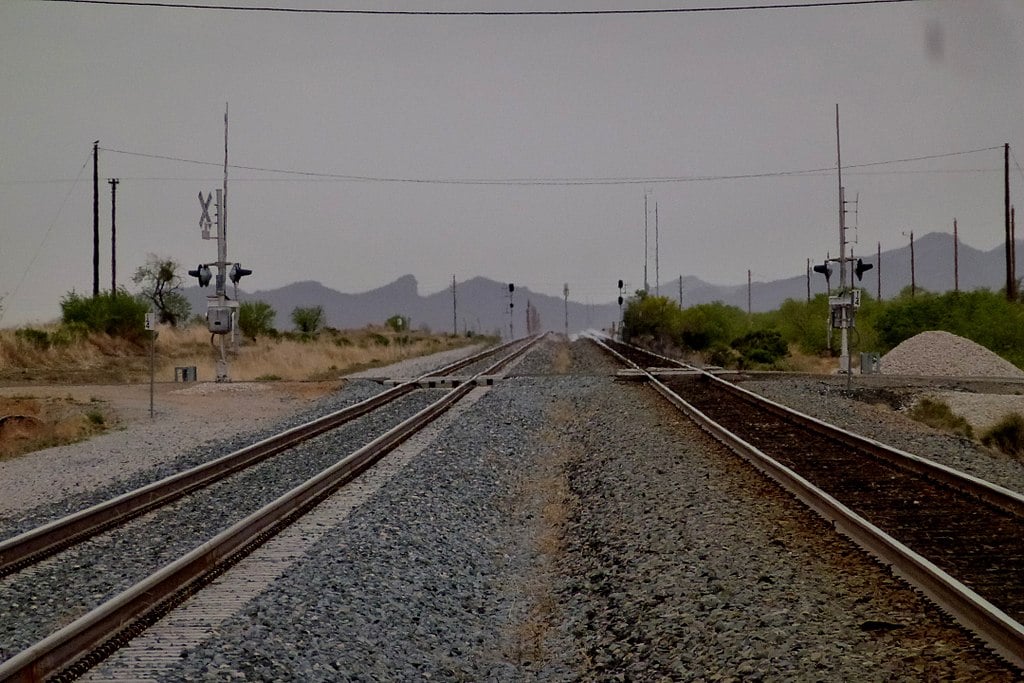
Why are people willing to pay so much to live here? What’s special about it?
Tortolita attracts buyers seeking luxury desert living with dramatic mountain views, golf courses, and upscale amenities in the foothills north of Tucson. The area offers custom homes on large lots, pristine desert landscapes, and resort-style living while maintaining proximity to Tucson’s employment and cultural opportunities. Residents value the exclusive atmosphere, outdoor recreation, and stunning natural setting that creates a premium desert lifestyle.
Unlike suburban developments, Tortolita features preserved desert terrain, mountain vistas, and architectural standards that maintain the natural beauty and property values. The community provides access to hiking, golf, and outdoor activities while offering privacy and space rare in urban areas. Limited development and environmental preservation help sustain the desert character that attracts affluent buyers seeking luxury living.
How Tortolita Rose to Prominence
Tortolita’s prominence began in the 1980s and 1990s as developers recognized the potential of the scenic foothills north of Tucson for luxury residential development. The area’s dramatic desert landscapes, mountain views, and proximity to the city made it attractive for upscale communities targeting affluent buyers. Early developments established the precedent for large lots, custom homes, and desert preservation that characterizes the area today.
The community’s growth accelerated as Tucson expanded northward and demand increased for luxury housing with natural settings. The development of golf courses, hiking trails, and exclusive neighborhoods attracted buyers seeking resort-style living in a desert environment. Today’s Tortolita represents successful luxury development that balances growth with environmental preservation, creating a premium community that commands high real estate values.
3 Interesting Tidbits
1. Desert Museum – The nearby Arizona-Sonora Desert Museum showcases the unique Sonoran Desert ecosystem and attracts visitors from around the world.
2. Saguaro Forest – The area features dense populations of giant saguaro cacti, creating iconic desert landscapes that enhance property values and visual appeal.
3. Mountain Access – Tortolita provides direct access to the Tortolita Mountains for hiking, rock climbing, and desert recreation activities.
11. Queen Creek – 215% Home Price Increase Since 2010

- 2010: $201,131
- 2011: $180,526
- 2012: $197,179
- 2013: $245,283
- 2014: $275,557
- 2015: $289,143
- 2016: $312,198
- 2017: $328,770
- 2018: $359,800
- 2019: $385,309
- 2020: $418,139
- 2021: $545,975
- 2022: $678,376
- 2023: $620,994
- 2024: $645,785
- 2025: $634,521
Queen Creek achieved exceptional 215% growth since 2010, demonstrating the strongest appreciation among all communities on this list. The town recovered dramatically from its 2011 low, showing consistent gains through the decade before surging during 2020-2022, when values jumped from $418,139 to over $678,000. Current median prices of $634,521 reflect the transformation of this former agricultural community into a sought-after East Valley destination.
Why Queen Creek?
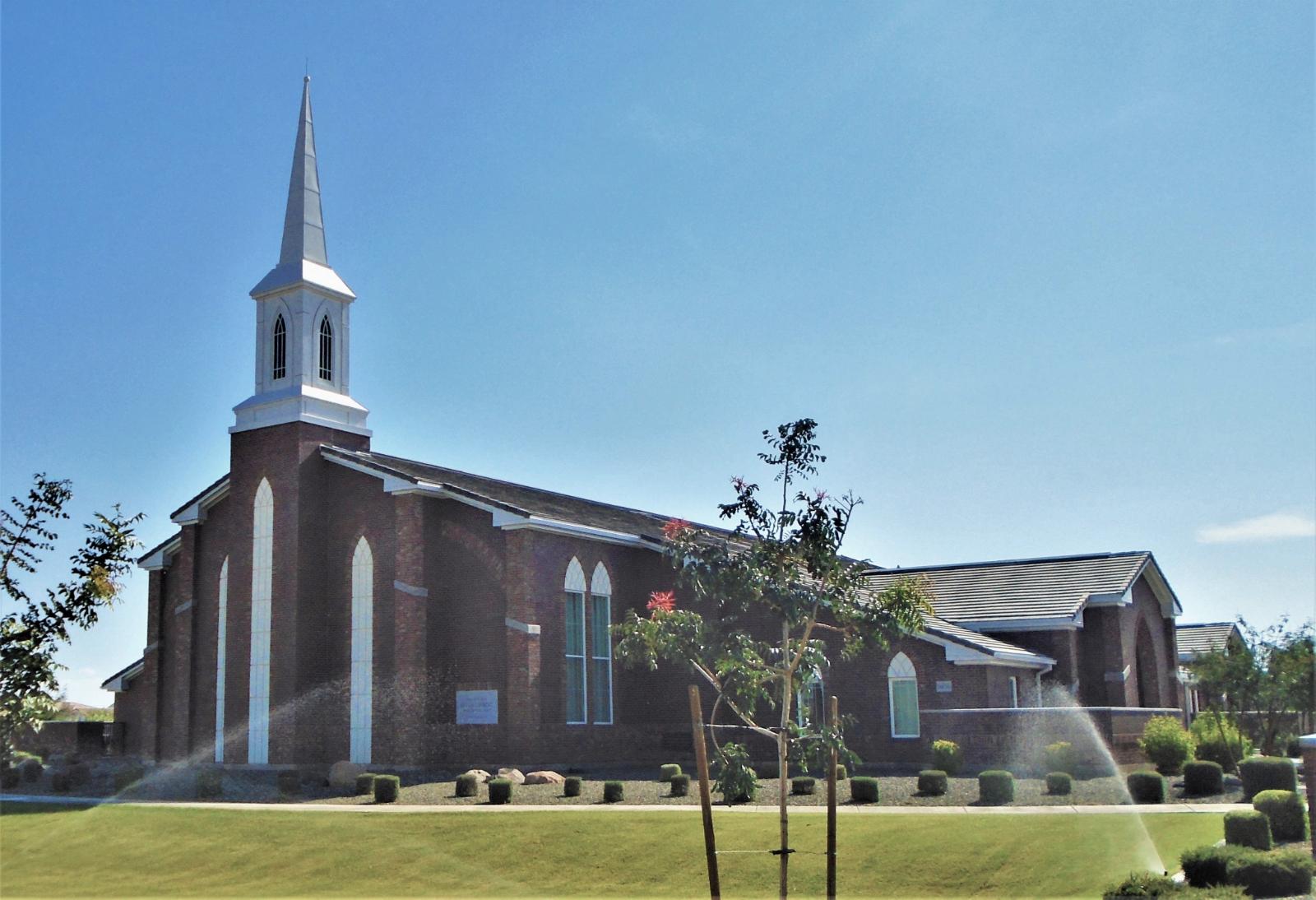
Why are people willing to pay so much to live here? What’s special about it?
Queen Creek attracts buyers seeking master-planned community living with new construction, excellent schools, and family-oriented amenities in a rapidly growing East Valley location. The town offers modern infrastructure, recreational facilities, and planned neighborhoods while maintaining access to outdoor recreation and agricultural heritage. Families value the safe communities, top-rated schools, and organized activities that create an ideal environment for raising children.
Unlike older suburbs, Queen Creek features contemporary development with planned open spaces, modern amenities, and architectural standards that maintain community character and property values. The area provides easy access to hiking, camping, and desert recreation while offering urban conveniences and employment opportunities. Master-planned communities create resort-style living with pools, golf courses, and community centers.
How Queen Creek Rose to Prominence
Queen Creek’s prominence began as an agricultural community in the early 1900s, focusing on cotton, citrus, and dairy farming in the fertile East Valley. The area remained primarily rural through most of the 20th century, developing a reputation for quality agricultural products and small-town values. The irrigation infrastructure and farming heritage created a foundation for the community’s later development.
The transformation to a major suburban center began in the 1990s when Phoenix’s growth reached the Southeast Valley, with Queen Creek offering available land and pro-development policies. The town’s commitment to planned development and quality infrastructure attracted major builders and young families seeking suburban amenities with small-town character. Today’s Queen Creek successfully balances rapid growth with community planning, creating a family-oriented environment that commands premium real estate prices.
3 Interesting Tidbits
1. Agricultural Heritage – Queen Creek maintains working farms and agricultural areas that preserve the community’s farming roots alongside modern development.
2. Master Planning – The town features some of Arizona’s most successful master-planned communities, setting standards for integrated residential and recreational development.
3. Desert Access – Queen Creek provides direct access to the Superstition Mountains and Lost Dutchman State Park for hiking and outdoor recreation.
10. Flagstaff – 151% Home Price Increase Since 2010
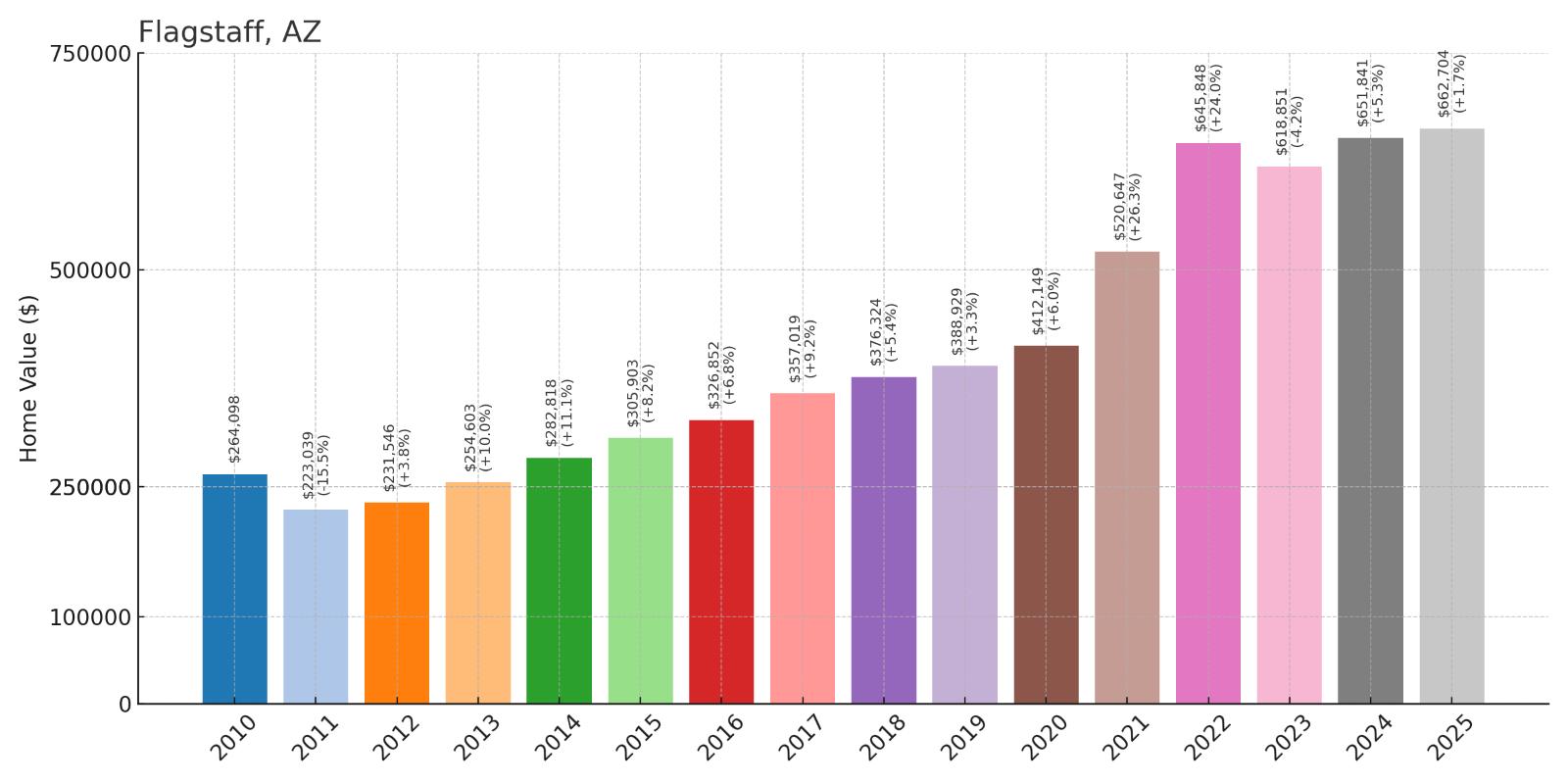
- 2010: $264,098
- 2011: $223,039
- 2012: $231,546
- 2013: $254,603
- 2014: $282,818
- 2015: $305,903
- 2016: $326,852
- 2017: $357,019
- 2018: $376,324
- 2019: $388,929
- 2020: $412,149
- 2021: $520,647
- 2022: $645,848
- 2023: $618,851
- 2024: $651,841
- 2025: $662,704
Flagstaff achieved solid 151% growth since 2010, showing consistent appreciation with particularly strong performance during the recent market surge. The city experienced steady gains through most periods before accelerating during 2020-2022, when values jumped from $412,149 to over $645,000. Current median prices of $662,704 reflect the premium status of this mountain university city and popular tourism destination.
Why Flagstaff?
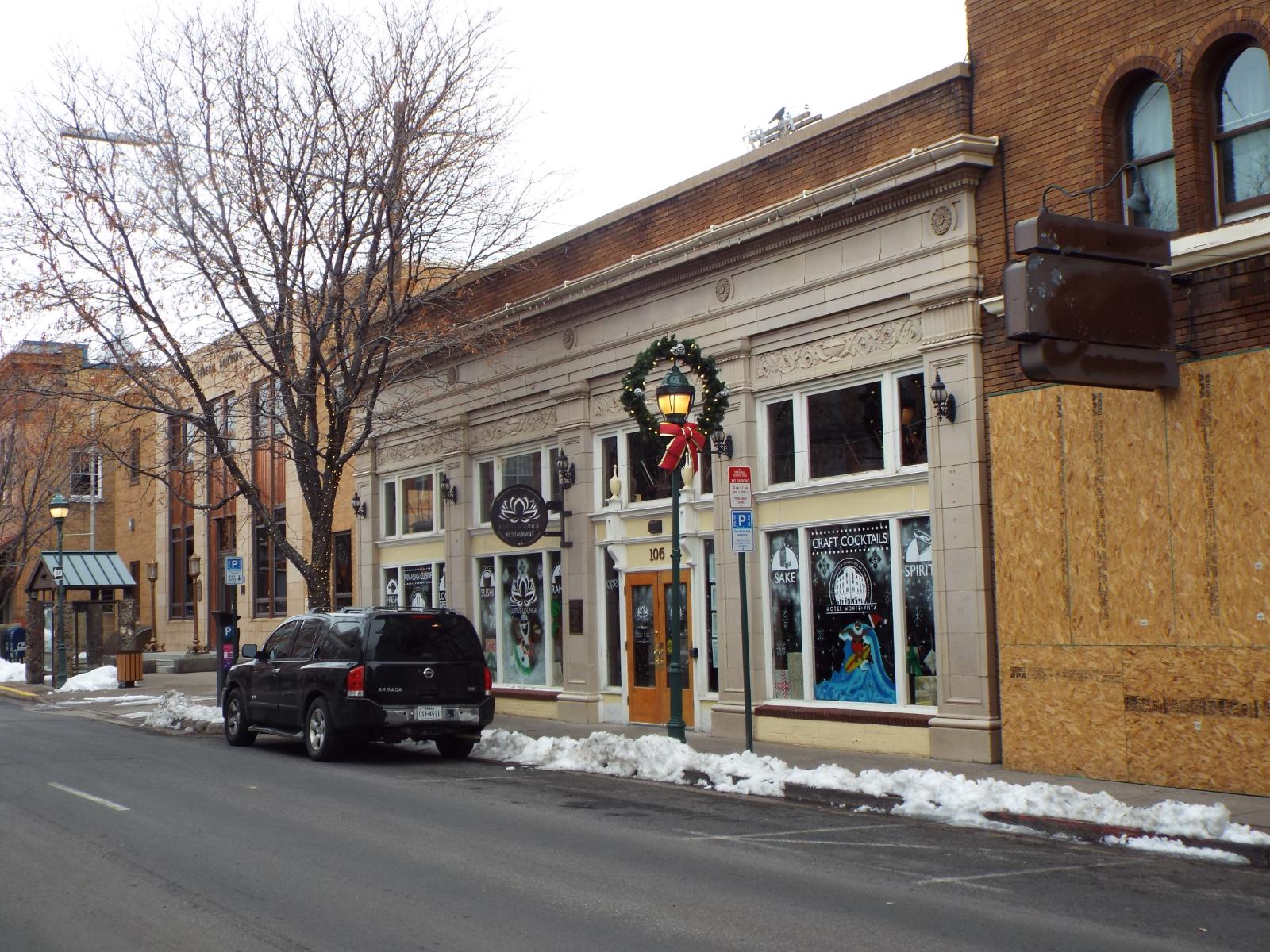
Why are people willing to pay so much to live here? What’s special about it?
Flagstaff attracts buyers seeking four-season mountain living with cultural amenities, educational opportunities, and outdoor recreation at high elevation. The city offers cooler temperatures, seasonal snow, and pine forests while providing access to Northern Arizona University, museums, and diverse dining and entertainment options. Residents value the authentic mountain lifestyle, proximity to national parks, and vibrant community that balances college town energy with outdoor recreation.
Unlike desert cities, Flagstaff provides true alpine experiences with skiing, hiking, and seasonal weather changes that appeal to outdoor enthusiasts. The city’s university presence creates cultural diversity and intellectual stimulation while historic downtown and local businesses maintain community character. Access to Grand Canyon, Sedona, and numerous wilderness areas enhances the lifestyle appeal that justifies premium property values.
How Flagstaff Rose to Prominence
Flagstaff’s prominence began in 1876 as a railroad town on the Atlantic and Pacific Railroad, serving as a supply center for ranching, lumber, and mining operations in northern Arizona. The city’s strategic location and transportation connections made it a commercial hub for the region, while the surrounding pine forests supported a thriving lumber industry. The establishment of Northern Arizona Normal School (now NAU) in 1899 added educational importance.
The development of Route 66 and later Interstate 40 enhanced Flagstaff’s role as a transportation center and tourist destination, providing access to Grand Canyon and other attractions. The growth of Northern Arizona University and the expansion of tourism created a diverse economy that supported residential development. Today’s Flagstaff successfully balances its railroad heritage with university culture and tourism, creating a mountain lifestyle that attracts buyers willing to pay premium prices for four-season living.
3 Interesting Tidbits
1. Route 66 – Historic Route 66 runs through downtown Flagstaff, preserving the city’s role in American transportation history and attracting tourists worldwide.
2. Observatory – Lowell Observatory in Flagstaff discovered Pluto in 1930 and continues as a major astronomical research facility taking advantage of the area’s dark skies.
3. San Francisco Peaks – The nearby San Francisco Peaks include Arizona’s highest point and provide skiing, hiking, and spiritual significance to local Native American tribes.
9. Fountain Hills – 122% Home Price Increase Since 2010

- 2010: $298,585
- 2011: $263,810
- 2012: $286,140
- 2013: $336,963
- 2014: $359,058
- 2015: $361,183
- 2016: $373,268
- 2017: $382,085
- 2018: $399,407
- 2019: $418,286
- 2020: $449,816
- 2021: $563,185
- 2022: $692,549
- 2023: $640,524
- 2024: $666,915
- 2025: $663,988
Fountain Hills shows solid 122% appreciation since 2010, starting from a higher baseline and maintaining steady growth throughout most periods. The community experienced consistent gains before accelerating during 2020-2022, when values jumped from $449,816 to nearly $693,000. Current median prices of $663,988 reflect the premium nature of this distinctive Scottsdale-area community known for its iconic fountain and desert beauty.
Why Fountain Hills?

Why are people willing to pay so much to live here? What’s special about it?
Fountain Hills attracts buyers seeking luxury desert living with unique amenities, stunning mountain views, and proximity to Scottsdale’s attractions. The town offers upscale neighborhoods, golf courses, and the world’s fourth-tallest fountain while maintaining a small-town atmosphere with excellent municipal services. Residents value the safe communities, recreational facilities, and distinctive character that creates an exclusive desert lifestyle.
Unlike larger cities, Fountain Hills maintains its planned community character with architectural standards, preserved desert areas, and the iconic central fountain that serves as a focal point for community life. The area provides access to hiking, golf, and outdoor recreation while offering proximity to Scottsdale’s shopping, dining, and entertainment options. Limited development and strict planning help maintain the exclusive atmosphere that drives property values.
How Fountain Hills Rose to Prominence
Fountain Hills’ prominence began in the 1970s as a master-planned community developed by real estate entrepreneur Robert McCulloch, who envisioned a unique desert town centered around a spectacular fountain. The community was designed with curved streets, desert preservation areas, and the iconic 560-foot fountain that became a signature attraction. The planned approach created a distinctive character that set it apart from typical suburban developments.
The development attracted buyers seeking luxury desert living with planned amenities and natural beauty, establishing Fountain Hills as an upscale alternative to larger cities. The preservation of desert landscapes and the creation of community amenities helped maintain property values and exclusive character. Today’s Fountain Hills successfully balances its planned community heritage with growth, maintaining the unique character and amenities that attract affluent buyers willing to pay premium prices.
3 Interesting Tidbits
1. World’s Fountain – The central fountain shoots water 560 feet high, making it one of the world’s tallest fountains and a distinctive landmark visible for miles.
2. Planned Paradise – The entire town was master-planned in the 1970s with curved streets and preserved desert areas that maintain the natural Sonoran landscape.
3. Art Scene – Fountain Hills hosts the annual Great Fair arts festival and maintains numerous public art installations throughout the community.
8. New River – 191% Home Price Increase Since 2010
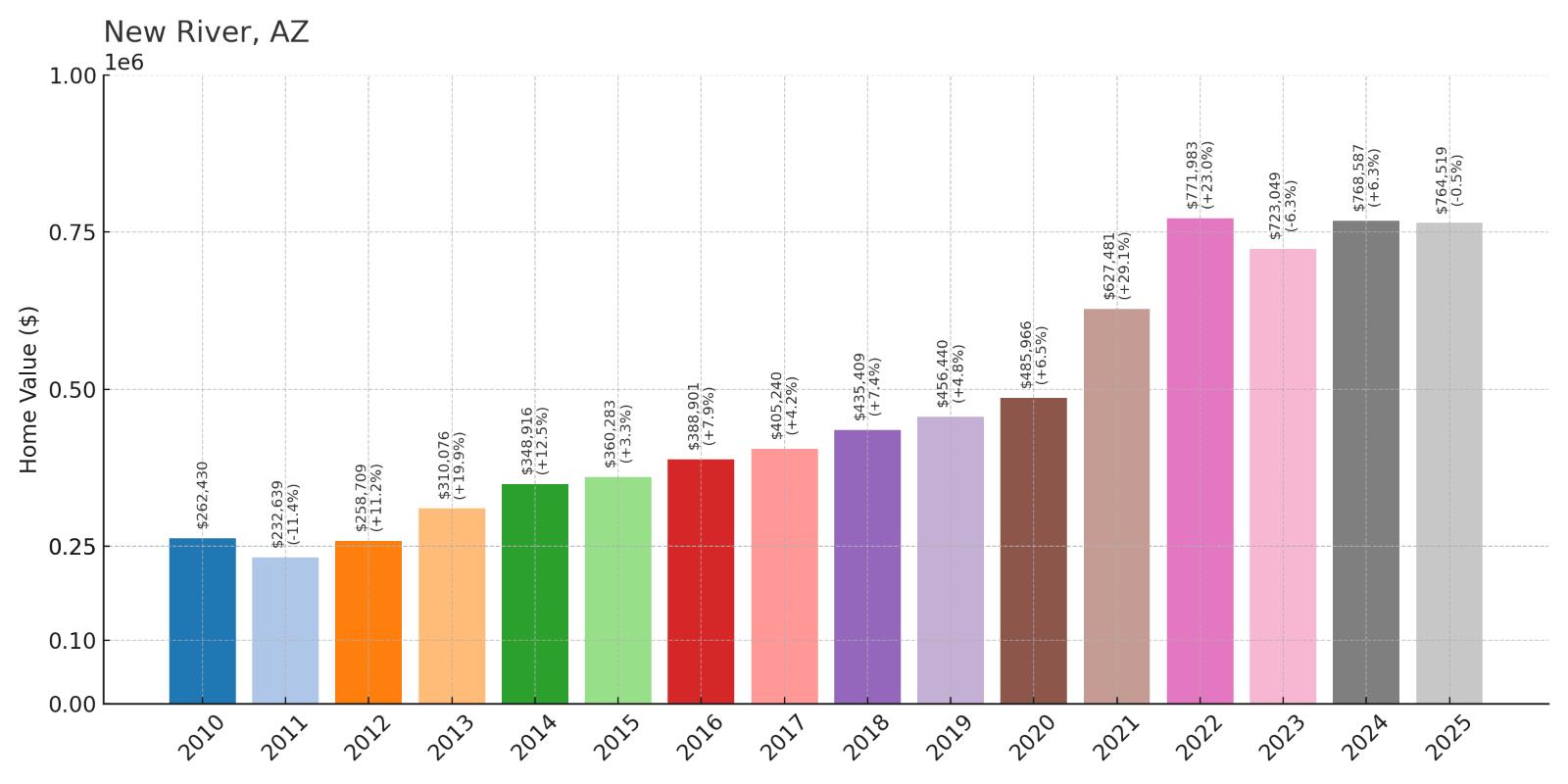
- 2010: $262,430
- 2011: $232,639
- 2012: $258,709
- 2013: $310,076
- 2014: $348,916
- 2015: $360,283
- 2016: $388,901
- 2017: $405,240
- 2018: $435,409
- 2019: $456,440
- 2020: $485,966
- 2021: $627,481
- 2022: $771,983
- 2023: $723,049
- 2024: $768,587
- 2025: $764,519
New River achieved exceptional 191% growth since 2010, demonstrating remarkable appreciation with particularly strong performance during recent years. The community showed consistent gains through the decade before surging during 2020-2022, when values jumped from $485,966 to nearly $772,000. Current median prices of $764,519 reflect the premium status of this North Phoenix desert community that offers luxury living with rural character.
Why New River?
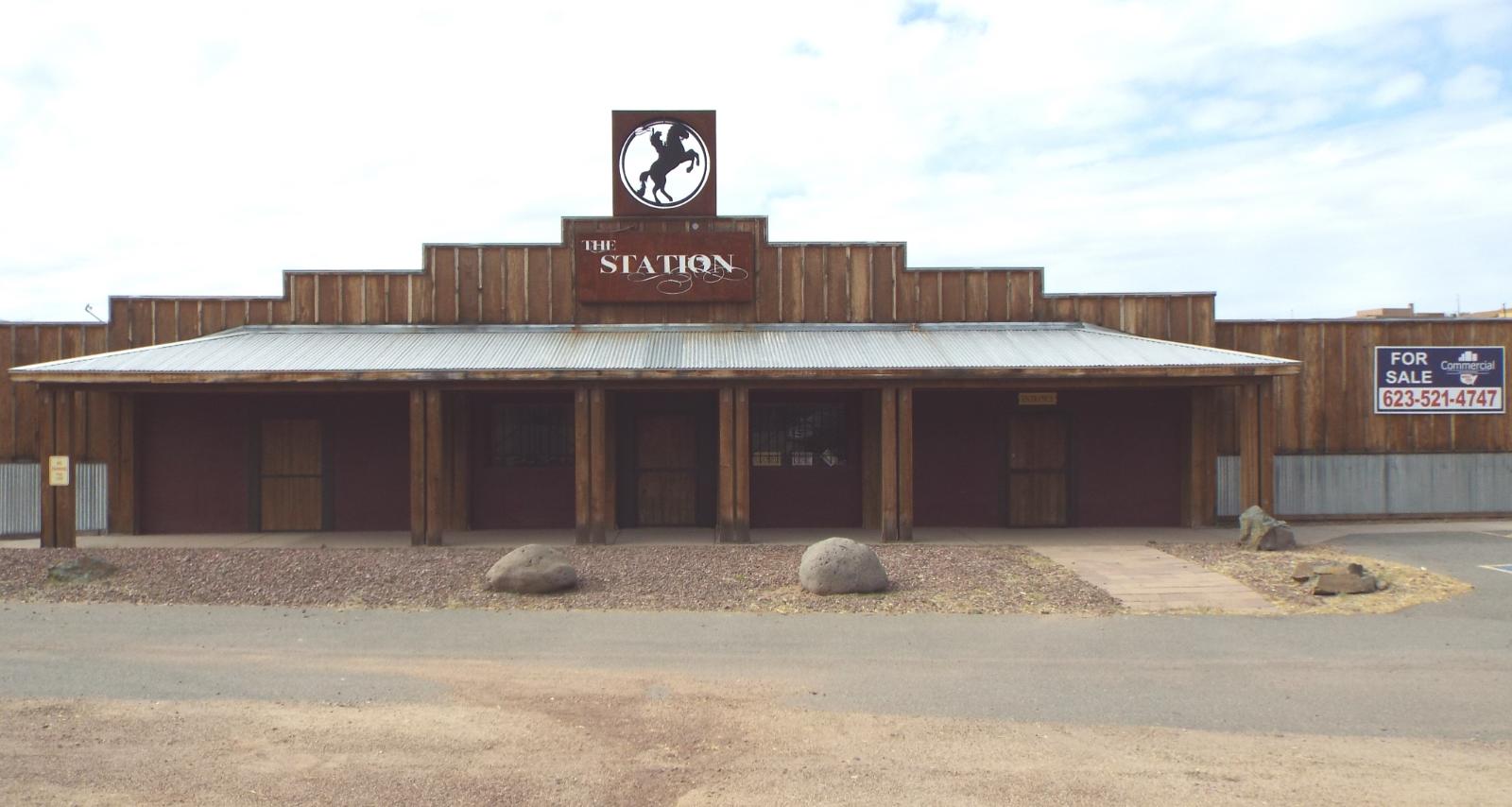
Why are people willing to pay so much to live here? What’s special about it?
New River attracts buyers seeking luxury desert living with large lots, custom homes, and proximity to Phoenix amenities while maintaining rural character and mountain views. The area offers equestrian properties, desert landscapes, and outdoor recreation opportunities while providing reasonable access to urban employment and services. Residents value the privacy, space, and authentic desert lifestyle that creates an exclusive atmosphere in the Sonoran Desert.
Unlike suburban developments, New River features large parcels, custom architecture, and preserved desert terrain that maintains the natural character and scenic beauty. The community provides access to hiking, horseback riding, and outdoor activities while offering proximity to Phoenix’s employment centers and cultural attractions. Limited development and rural zoning help preserve the open spaces and desert views that drive premium property values.
How New River Rose to Prominence
New River’s prominence began in the early 1900s as a ranching and mining area in the high Sonoran Desert north of Phoenix, taking advantage of seasonal water sources and grazing land for cattle operations. The community remained largely agricultural and rural through most of the 20th century, attracting those seeking wide-open spaces and authentic desert living. The area’s natural beauty and proximity to Phoenix made it attractive for custom home development.
The transformation to a luxury residential area began in the 1980s and 1990s when Phoenix’s growth reached the north valley and buyers sought alternatives to suburban development. The availability of large lots and scenic desert settings attracted affluent buyers wanting custom homes with privacy and mountain views. Today’s New River successfully balances rural character with luxury amenities, creating an exclusive desert community that commands premium real estate prices.
3 Interesting Tidbits
1. Horse Country – New River features numerous equestrian properties and horse facilities, maintaining Arizona’s ranching heritage in a luxury setting.
2. Desert Preserve – Large areas of pristine Sonoran Desert are preserved, providing habitat for wildlife and maintaining the natural character that enhances property values.
3. Custom Homes – The area is known for custom-designed homes that blend with the desert landscape, creating unique architectural expressions of Southwest living.
7. Rio Verde – 103% Home Price Increase Since 2010

- 2010: $405,775
- 2011: $382,788
- 2012: $391,691
- 2013: $420,842
- 2014: $449,947
- 2015: $460,914
- 2016: $457,105
- 2017: $480,273
- 2018: $491,722
- 2019: $514,783
- 2020: $555,734
- 2021: $676,036
- 2022: $846,694
- 2023: $810,006
- 2024: $829,347
- 2025: $825,380
Rio Verde shows solid 103% appreciation since 2010, starting from a higher baseline and maintaining steady growth with accelerated gains during recent years. The community experienced consistent appreciation before surging during 2020-2022, when values jumped from $555,734 to over $846,000. Current median prices of $825,380 reflect the exclusive nature of this North Scottsdale-area community known for luxury desert living and equestrian properties.
Why Rio Verde?
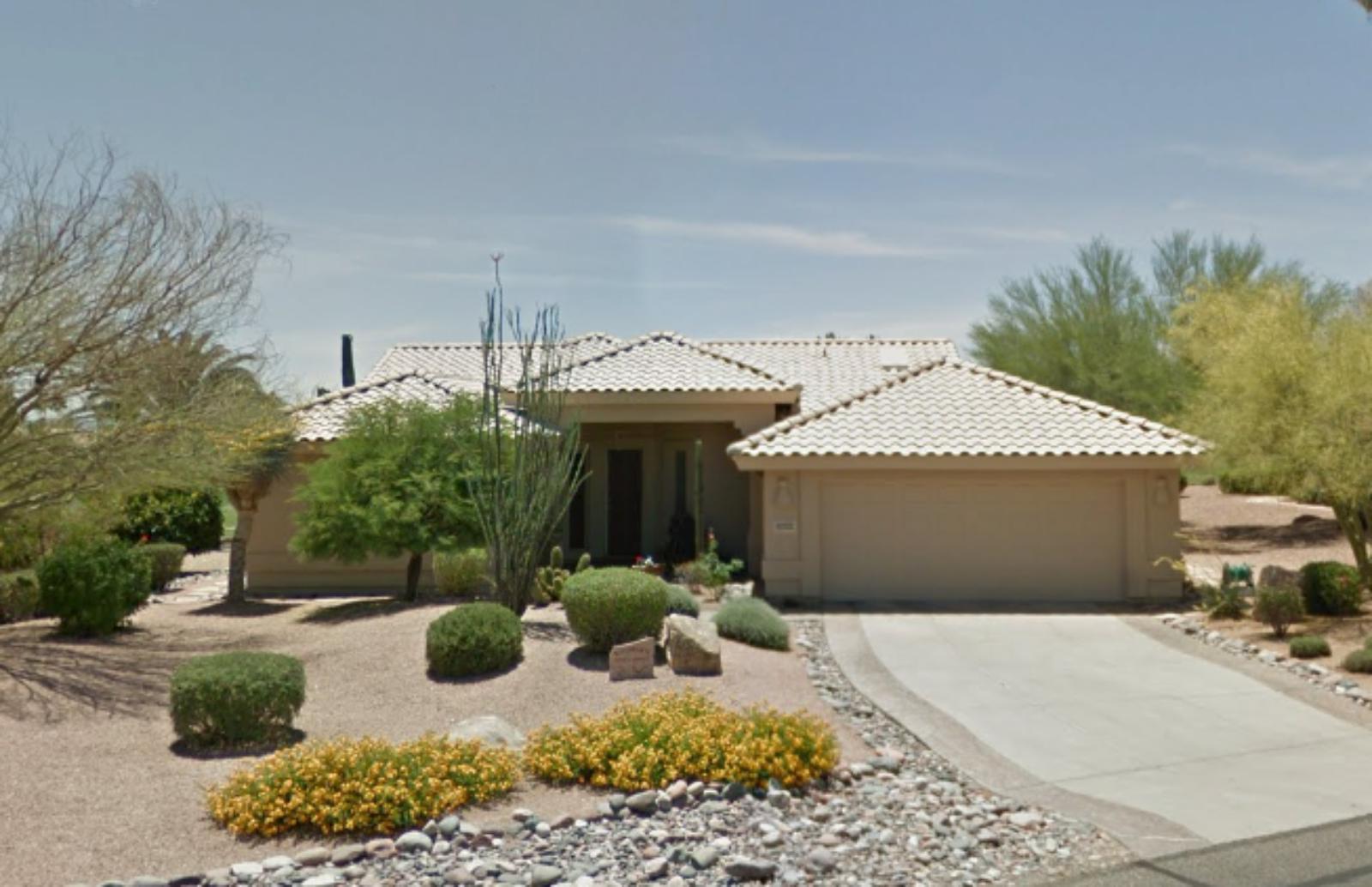
Why are people willing to pay so much to live here? What’s special about it?
Rio Verde attracts buyers seeking ultra-luxury desert living with expansive lots, custom estates, and stunning mountain views in an exclusive Sonoran Desert setting. The area offers equestrian facilities, golf courses, and resort-style amenities while providing privacy and space rare in Arizona’s metropolitan areas. Residents value the authentic desert lifestyle, architectural freedom, and proximity to Scottsdale’s amenities while maintaining rural character and natural beauty.
Unlike suburban developments, Rio Verde features very large parcels, custom architecture, and preserved desert landscapes that create an exclusive atmosphere with spectacular views. The community provides access to outdoor recreation, horseback riding, and desert activities while offering proximity to Phoenix’s employment and cultural opportunities. Strict development standards and rural zoning help maintain the open character that drives premium property values.
How Rio Verde Rose to Prominence
Rio Verde’s prominence began in the early 1900s as a ranching area in the upper Sonoran Desert, taking advantage of the Verde River watershed and natural grazing lands for cattle operations. The area remained largely agricultural through most of the 20th century, attracting those seeking authentic Western lifestyles and wide-open spaces. The natural beauty and water access made it distinctive among Arizona’s desert communities.
The transformation to an exclusive residential area began in the 1970s and 1980s when Scottsdale’s growth created demand for luxury properties with larger lots and rural character. The availability of scenic desert settings and proximity to urban amenities attracted affluent buyers seeking custom estates with privacy and natural beauty. Today’s Rio Verde represents successful luxury development that preserves desert character while providing exclusive amenities that command premium real estate prices.
3 Interesting Tidbits
1. Verde River – Rio Verde takes its name from the nearby Verde River, one of Arizona’s few year-round flowing rivers that supports unique riparian ecosystems.
2. Equestrian Culture – The area maintains a strong equestrian tradition with horse properties, riding trails, and facilities that preserve Arizona’s ranching heritage.
3. Desert Views – Properties feature panoramic views of multiple mountain ranges and pristine Sonoran Desert that enhance the exclusive character and property values.
6. Scottsdale – 154% Home Price Increase Since 2010

- 2010: $326,972
- 2011: $294,415
- 2012: $324,686
- 2013: $381,219
- 2014: $409,202
- 2015: $415,626
- 2016: $431,857
- 2017: $450,684
- 2018: $478,949
- 2019: $497,744
- 2020: $535,050
- 2021: $682,876
- 2022: $866,326
- 2023: $803,061
- 2024: $840,107
- 2025: $831,655
Scottsdale achieved impressive 154% growth since 2010, demonstrating the strength of this premier Arizona destination throughout the market cycle. The city experienced steady appreciation with particularly strong performance during 2012-2014 and the pandemic surge of 2020-2022, when values jumped from $535,050 to over $866,000. Current median prices of $831,655 reflect Scottsdale’s position as Arizona’s premier luxury market and international destination.
Why Scottsdale?

Why are people willing to pay so much to live here? What’s special about it?
Scottsdale attracts buyers seeking world-class luxury living with resort amenities, championship golf courses, and sophisticated urban culture in a stunning desert setting. The city offers upscale shopping, fine dining, art galleries, and entertainment while providing access to outdoor recreation and year-round sunshine. Residents value the premium lifestyle, excellent services, and international reputation that creates one of America’s most desirable luxury markets.
Unlike other cities, Scottsdale has cultivated a unique brand combining Western heritage with contemporary sophistication, attracting affluent buyers from around the world. The city’s commitment to architectural standards, desert preservation, and cultural amenities maintains property values while creating distinctive neighborhoods. Golf courses, spas, and resort hotels provide lifestyle amenities that enhance the appeal for luxury property buyers.
How Scottsdale Rose to Prominence
Scottsdale’s prominence began in 1888 when Army Chaplain Winfield Scott established a farming community in the Salt River Valley, taking advantage of irrigation systems and fertile desert soil. The area remained primarily agricultural through the early 20th century before evolving into a resort destination when luxury hotels and guest ranches began attracting wealthy visitors seeking desert experiences and winter escapes.
The transformation to a luxury city accelerated after World War II when improved transportation and air conditioning made desert living more attractive to affluent residents and businesses. The development of world-class golf courses, resorts, and cultural amenities established Scottsdale’s reputation as a premier destination. Today’s Scottsdale successfully balances growth with character preservation, creating a luxury market that attracts international buyers and commands premium real estate prices.
3 Interesting Tidbits
1. Golf Capital – Scottsdale features more golf courses per capita than any other city in the world, with over 200 courses in the greater area.
2. Art Scene – The city hosts more than 100 galleries and art spaces, making it one of the top art destinations in the American Southwest.
3. Spring Training – Scottsdale Stadium hosts the San Francisco Giants for spring training, adding to the city’s reputation as a sports and entertainment destination.
5. Sedona – 150% Home Price Increase Since 2010

- 2010: $361,903
- 2011: $330,990
- 2012: $341,170
- 2013: $377,007
- 2014: $409,332
- 2015: $425,412
- 2016: $442,106
- 2017: $456,428
- 2018: $491,551
- 2019: $530,265
- 2020: $564,805
- 2021: $734,963
- 2022: $948,024
- 2023: $884,841
- 2024: $930,581
- 2025: $904,139
Sedona achieved solid 150% growth since 2010, starting from a higher baseline and maintaining steady appreciation throughout most periods. The city experienced consistent gains before accelerating dramatically during 2020-2022, when values jumped from $564,805 to nearly $948,000. Current median prices of $904,139 reflect Sedona’s status as one of Arizona’s most iconic and sought-after destinations for luxury real estate.
Why Sedona?

Why are people willing to pay so much to live here? What’s special about it?
Sedona attracts buyers seeking spectacular red rock living with spiritual significance, outdoor recreation, and artistic culture in one of America’s most beautiful natural settings. The city offers world-class hiking, photography opportunities, and wellness retreats while providing upscale dining, galleries, and resort amenities. Residents value the stunning landscapes, temperate climate, and unique energy that creates an unparalleled lifestyle in the red rock country.
Unlike desert cities, Sedona features dramatic red sandstone formations, creek access, and elevation that provides four-season weather with milder summers and occasional snow. The area’s spiritual reputation and artistic community attract buyers seeking inspiration and natural beauty combined with luxury amenities. Limited development due to Forest Service land helps preserve the natural setting that drives premium property values.
How Sedona Rose to Prominence
Sedona’s prominence began in the late 1800s when early settlers established ranching and farming operations in Oak Creek Canyon, taking advantage of the area’s water sources and temperate climate. The community remained small and isolated until the 1950s when improved roads and the discovery of its photogenic landscapes by Hollywood filmmakers brought national attention to the red rock country.
The transformation to a tourism and arts destination accelerated in the 1960s and 1970s when the area’s natural beauty and spiritual significance attracted artists, writers, and alternative lifestyle seekers. The development of resorts, galleries, and wellness centers established Sedona’s reputation as a unique destination combining natural wonder with luxury amenities. Today’s Sedona successfully balances tourism with residential development, creating a lifestyle that attracts buyers willing to pay premium prices for red rock living.
3 Interesting Tidbits
1. Energy Vortexes – Sedona is famous for its supposed energy vortexes, spiritual sites that attract visitors from around the world seeking healing and meditation experiences.
2. Film Location – The red rocks have served as the backdrop for hundreds of Western movies and TV shows, making Sedona’s landscapes instantly recognizable worldwide.
3. Dark Sky – Sedona maintains International Dark-Sky Community status, preserving spectacular night sky viewing for astronomy enthusiasts and stargazers.
4. Fort McDowell – 96.1% increase since 2013
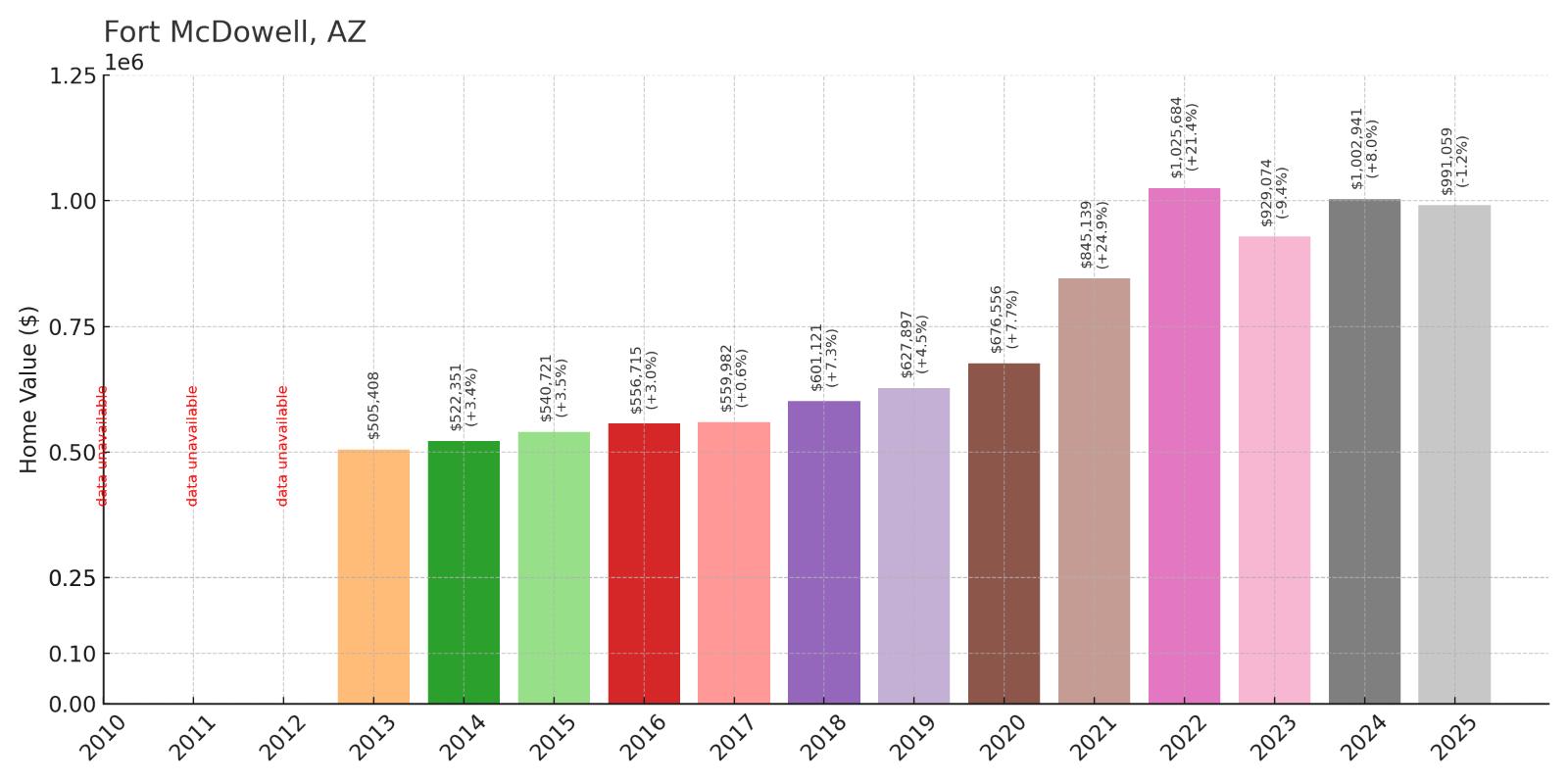
- 2010: N/A
- 2011: N/A
- 2012: N/A
- 2013: $505,408
- 2014: $522,351
- 2015: $540,721
- 2016: $556,715
- 2017: $559,982
- 2018: $601,121
- 2019: $627,897
- 2020: $676,556
- 2021: $845,139
- 2022: $1,025,684
- 2023: $929,074
- 2024: $1,002,941
- 2025: $991,059
Fort McDowell shows strong 96% appreciation since data became available in 2013, starting from an already elevated baseline and maintaining steady growth through most periods. The community experienced gradual gains before accelerating during 2020-2022, when values jumped from $676,556 to over $1 million. Current median prices of $991,059 position Fort McDowell among Arizona’s most exclusive communities despite limited historical data.
Why Fort McDowell?
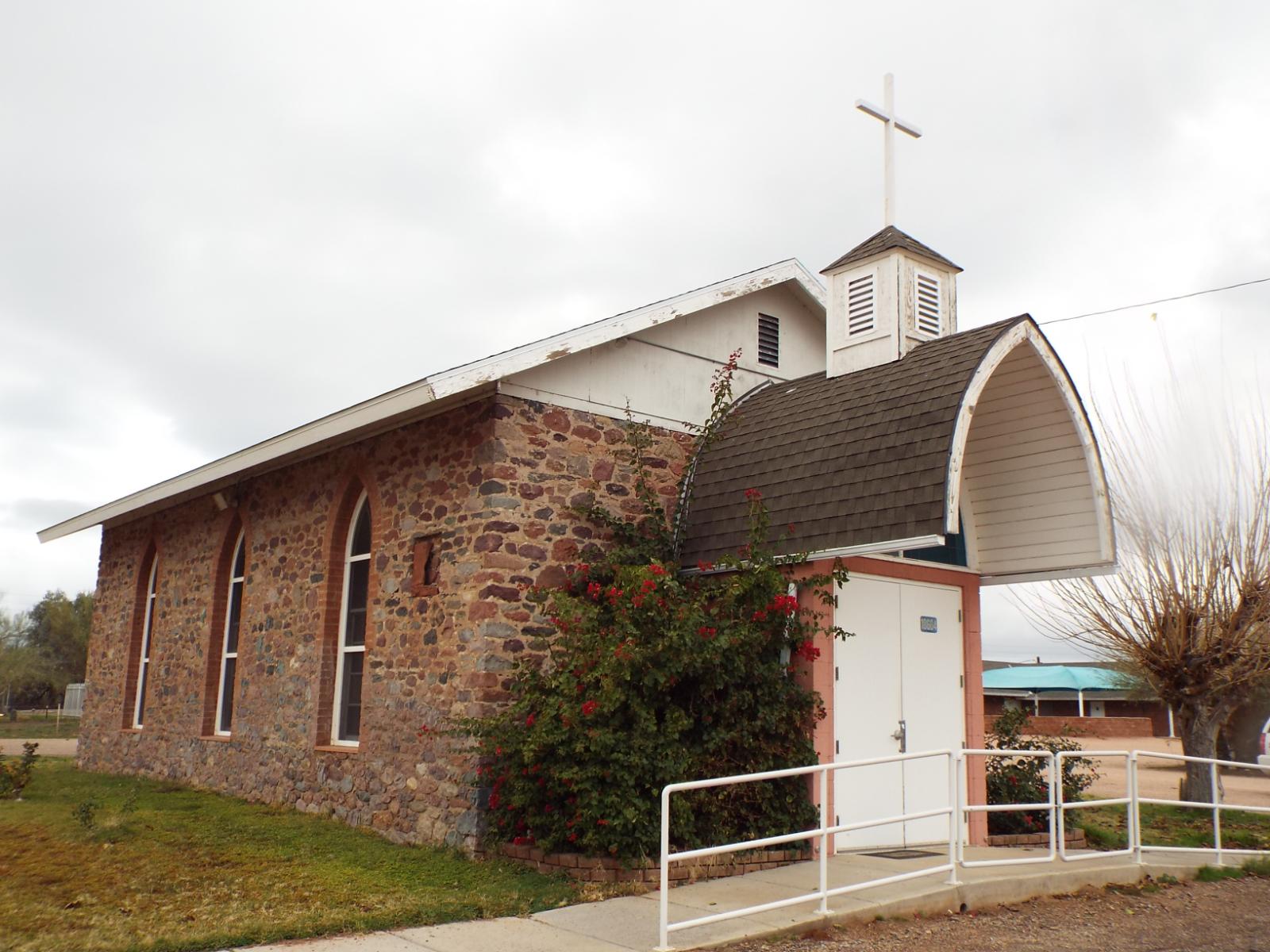
Why are people willing to pay so much to live here? What’s special about it?
Fort McDowell attracts buyers seeking ultra-exclusive desert living with pristine Sonoran landscapes, proximity to Scottsdale amenities, and unique cultural significance on tribal land. The area offers custom estates, spectacular mountain views, and access to outdoor recreation while providing privacy and authenticity rare in Arizona’s luxury markets. Residents value the cultural heritage, natural preservation, and exclusive atmosphere that creates a truly distinctive desert lifestyle.
Unlike other luxury communities, Fort McDowell features authentic Native American heritage, preserved desert terrain, and limited development that maintains the natural character and cultural significance. The area provides access to outdoor activities, casino entertainment, and spa facilities while offering proximity to Scottsdale’s urban amenities. Strict development controls and cultural preservation help maintain the exclusive character that drives premium property values.
How Fort McDowell Rose to Prominence
Fort McDowell’s prominence began with its establishment as a U.S. Army fort in 1865 to protect settlers and mining operations in the Verde Valley, serving as a strategic military post during the Apache Wars. The area later became part of the Fort McDowell Yavapai Nation reservation, preserving the cultural heritage and natural landscapes that characterize the region today. The military and tribal history created a unique foundation for later development.
The evolution to a luxury residential destination began in recent decades when the tribe developed carefully planned communities that balance economic development with cultural preservation and environmental stewardship. The creation of upscale residential areas, resort amenities, and casino facilities attracted affluent buyers seeking authentic experiences in pristine desert settings. Today’s Fort McDowell represents successful development that honors cultural heritage while creating exclusive amenities that command premium real estate prices.
3 Interesting Tidbits
1. Tribal Heritage – Fort McDowell is located on the Fort McDowell Yavapai Nation reservation, providing authentic Native American cultural experiences and heritage preservation.
2. Historic Fort – Remnants of the original 1865 military fort remain, preserving Arizona’s frontier military history and adding historical significance to the area.
3. Desert Preservation – The community maintains thousands of acres of pristine Sonoran Desert, providing habitat for wildlife and preserving the natural beauty that enhances property values.
3. Cave Creek – 153% Home Price Increase Since 2010
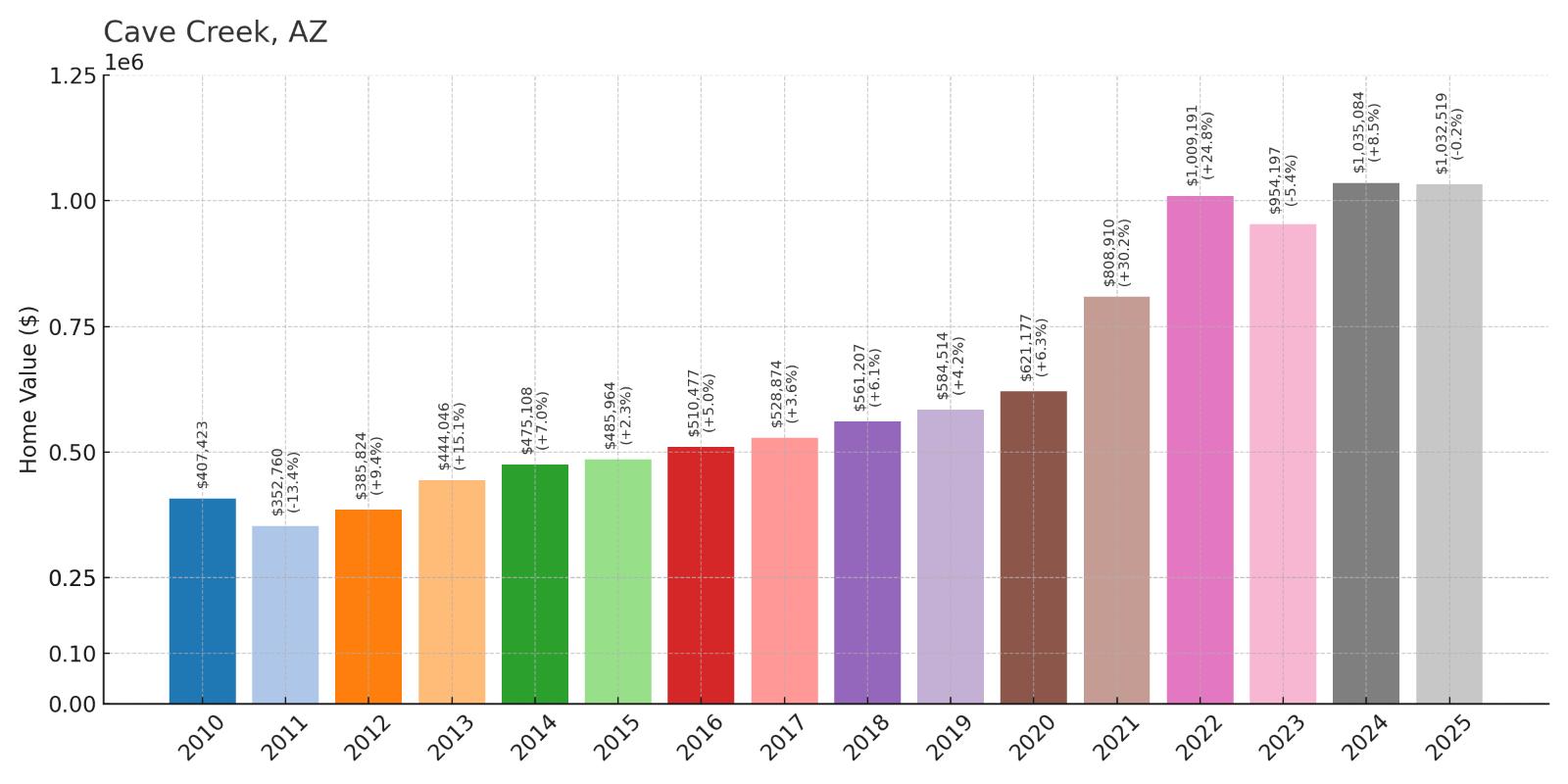
- 2010: $407,423
- 2011: $352,760
- 2012: $385,824
- 2013: $444,046
- 2014: $475,108
- 2015: $485,964
- 2016: $510,477
- 2017: $528,874
- 2018: $561,207
- 2019: $584,514
- 2020: $621,177
- 2021: $808,910
- 2022: $1,009,191
- 2023: $954,197
- 2024: $1,035,084
- 2025: $1,032,519
Cave Creek achieved excellent 153% growth since 2010, starting from a higher baseline and maintaining consistent appreciation throughout the period. The town experienced steady gains before surging during 2020-2022, when values jumped from $621,177 to over $1 million. Current median prices of $1,032,519 reflect Cave Creek’s status as one of Arizona’s most distinctive and desirable luxury communities, combining Western heritage with upscale living.
Why Cave Creek?
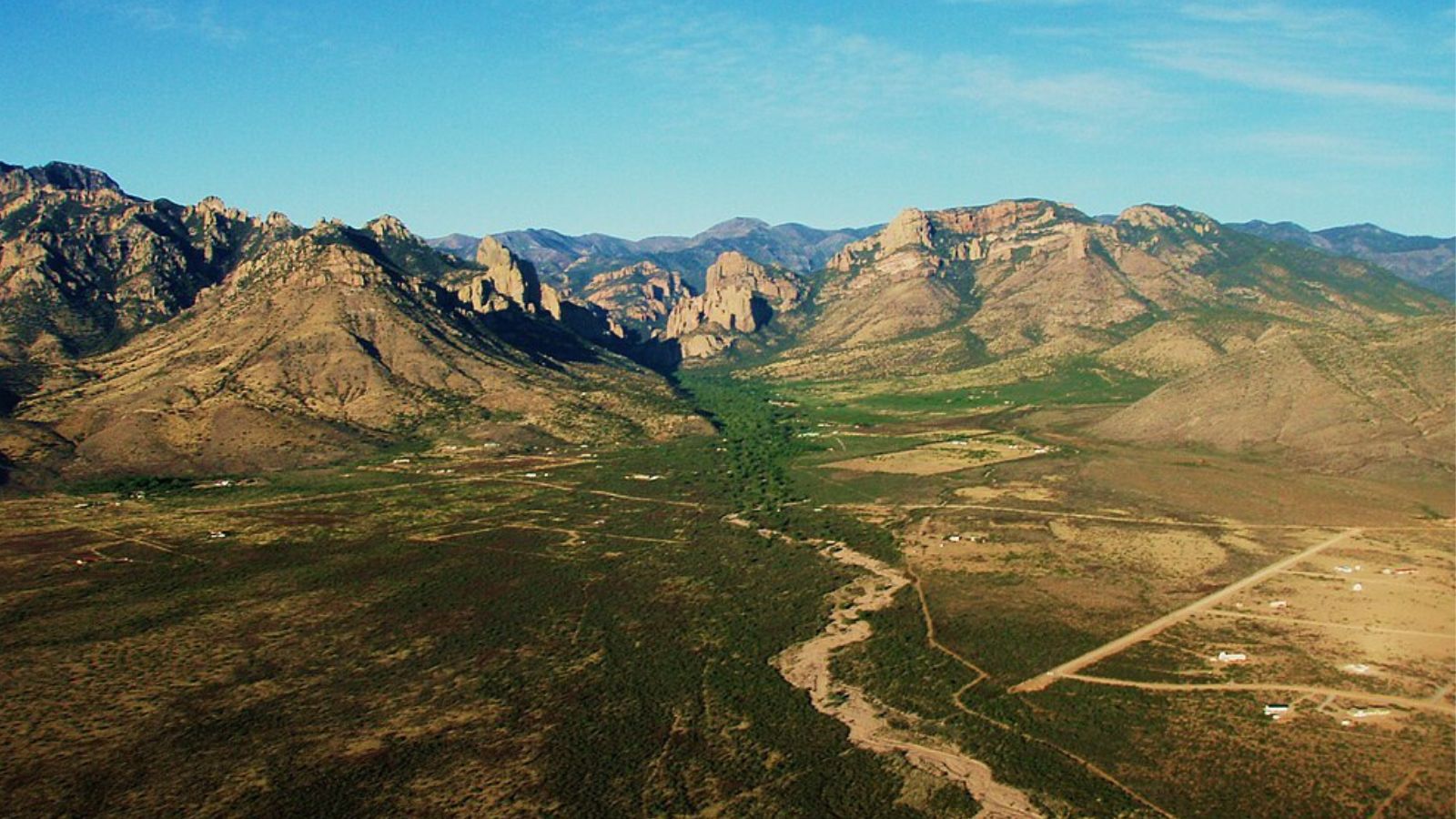
Why are people willing to pay so much to live here? What’s special about it?
Cave Creek attracts buyers seeking authentic Western luxury with historic charm, desert beauty, and proximity to Scottsdale amenities while maintaining small-town character. The area offers custom homes on large lots, equestrian properties, and access to outdoor recreation while preserving the Old West atmosphere with saloons, western events, and cowboy culture. Residents value the unique blend of rustic authenticity and modern luxury that creates an unmatched lifestyle.
Unlike suburban developments, Cave Creek maintains its frontier character with preserved desert landscapes, working ranches, and architectural standards that honor Western heritage while providing luxury amenities. The town’s commitment to preserving its cowboy culture and natural setting creates exclusivity and character that appeal to buyers seeking authentic Arizona experiences. Limited development and strict zoning help maintain the rural atmosphere that drives premium property values.
How Cave Creek Rose to Prominence
Cave Creek’s prominence began in the 1870s as a mining and ranching center in the high Sonoran Desert, taking advantage of natural springs and desert grazing lands for cattle operations. The area served as a supply point for gold and silver mines in the surrounding mountains while maintaining its ranching identity throughout the frontier period. The combination of mining activity and cattle ranching created the Western culture that defines the community today.
The transformation to a luxury destination began in the mid-20th century when Phoenix’s growth reached the north valley and buyers discovered Cave Creek’s authentic Western character and natural beauty. The preservation of historic buildings, saloons, and ranching activities attracted affluent buyers seeking genuine Arizona experiences combined with modern amenities. Today’s Cave Creek successfully balances development with heritage preservation, creating a Western luxury market that commands premium real estate prices.
3 Interesting Tidbits
1. Wild West Heritage – Cave Creek maintains working saloons, rodeo events, and Western entertainment that preserve authentic cowboy culture in a luxury setting.
2. Desert Blooms – The area features some of Arizona’s most spectacular wildflower displays during spring blooming seasons, enhancing the natural beauty and property appeal.
3. Frontier Town – The historic Frontier Town attraction preserves Old West buildings and activities, maintaining the area’s heritage while attracting visitors and residents.
2. Carefree – 158% Home Price Increase Since 2010
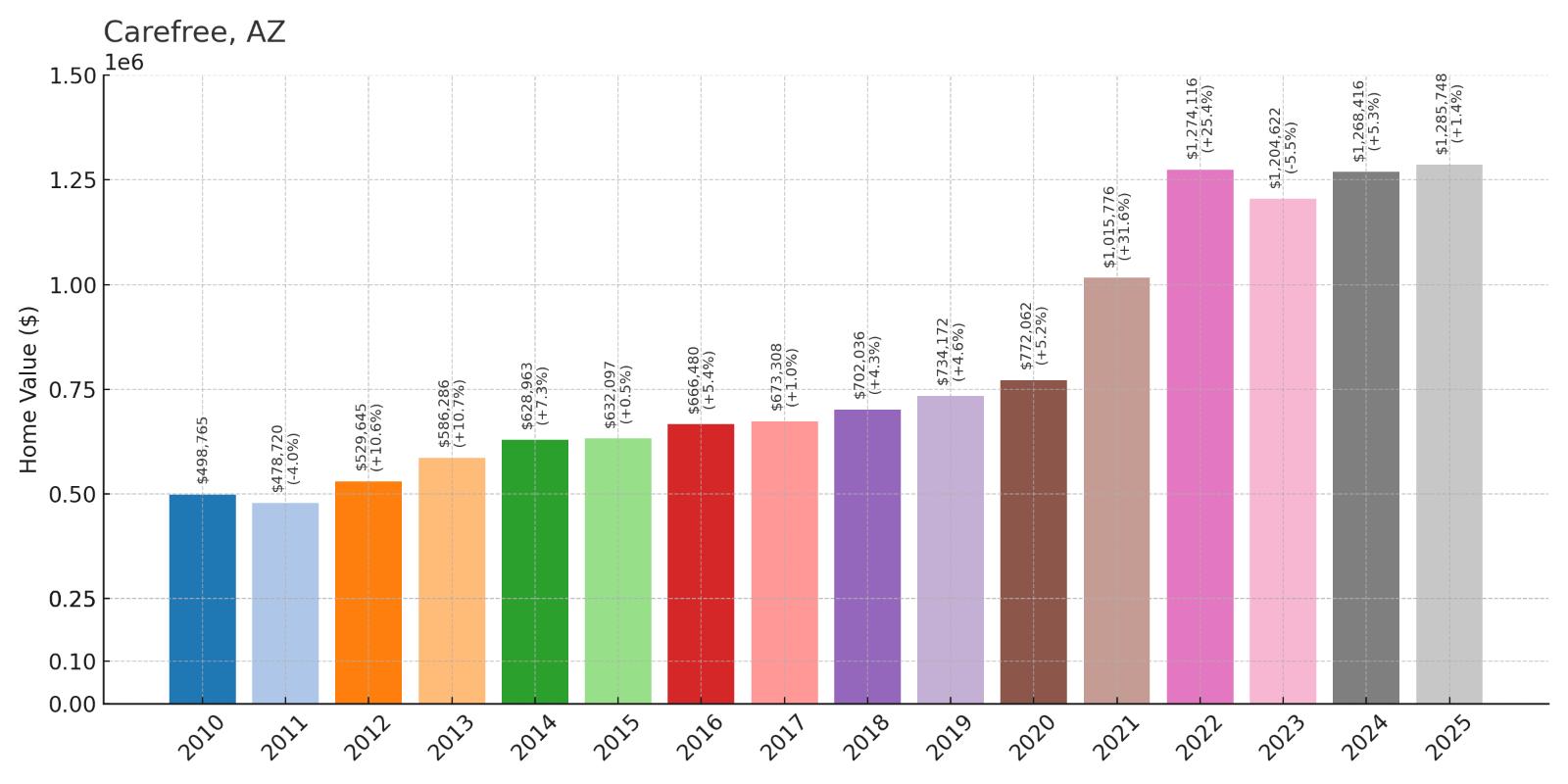
- 2010: $498,765
- 2011: $478,720
- 2012: $529,645
- 2013: $586,286
- 2014: $628,963
- 2015: $632,097
- 2016: $666,480
- 2017: $673,308
- 2018: $702,036
- 2019: $734,172
- 2020: $772,062
- 2021: $1,015,776
- 2022: $1,274,116
- 2023: $1,204,622
- 2024: $1,268,416
- 2025: $1,285,748
Carefree achieved impressive 158% growth since 2010, starting from an already elevated baseline and maintaining steady appreciation throughout most periods. The town experienced consistent gains before accelerating dramatically during 2020-2022, when values jumped from $772,062 to over $1.27 million. Current median prices of $1,285,748 position Carefree as Arizona’s second-most expensive community, reflecting its status as a premier desert luxury destination.
Why Carefree?
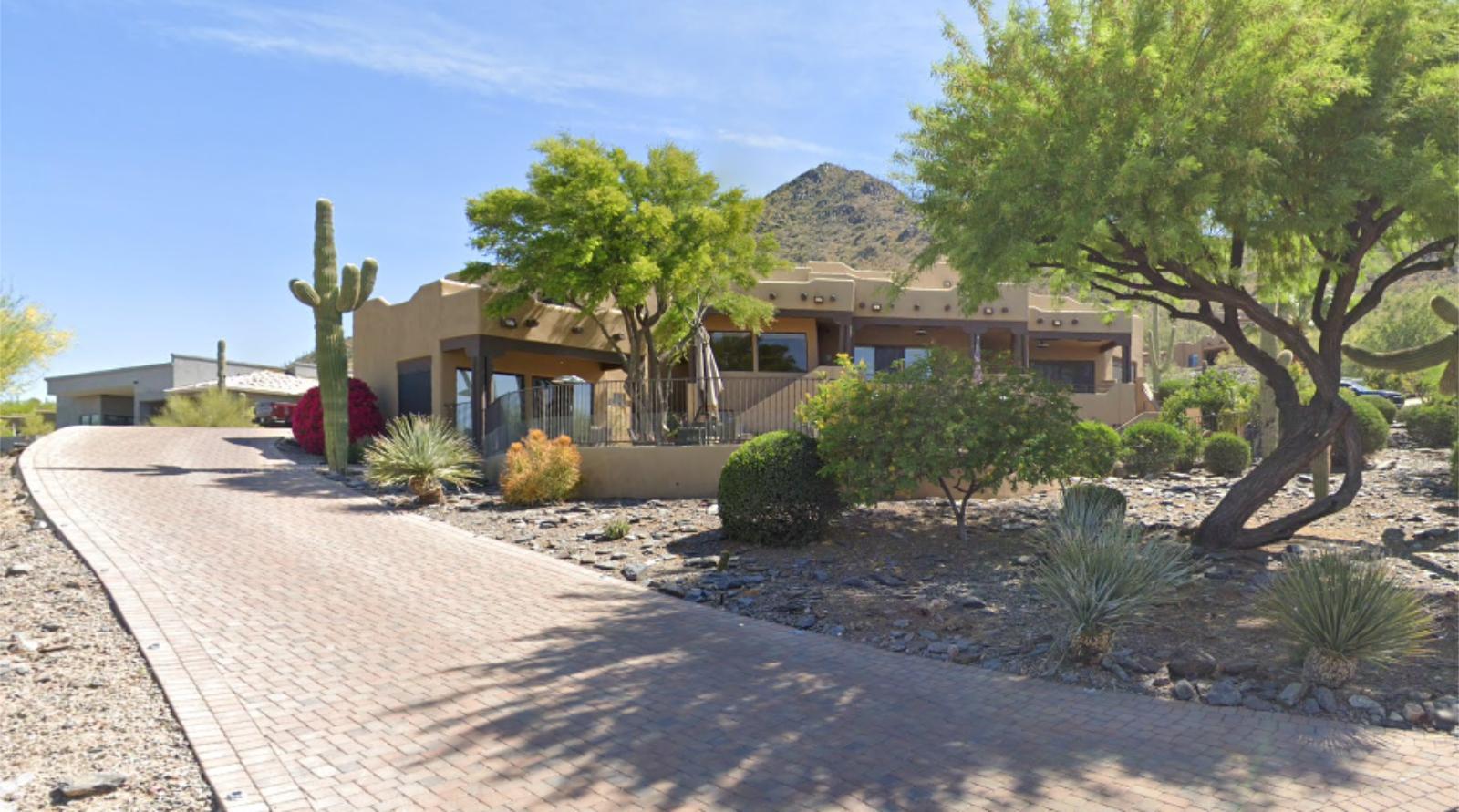
Why are people willing to pay so much to live here? What’s special about it?
Carefree attracts buyers seeking ultra-luxury desert living with world-class amenities, stunning mountain views, and proximity to Scottsdale’s attractions in a tranquil, master-planned setting. The town offers resort-style communities, championship golf courses, and spa facilities while maintaining desert preservation areas and architectural standards that create an exclusive atmosphere. Residents value the peaceful environment, natural beauty, and sophisticated amenities that provide resort living as a lifestyle.
Unlike larger cities, Carefree maintains its planned community character with strict development standards, preserved desert landscapes, and the famous sundial that serves as a community focal point. The town’s commitment to maintaining low density and high standards creates exclusivity and tranquility that appeal to affluent buyers seeking luxury desert experiences. Golf courses, hiking trails, and spa resorts provide world-class amenities that enhance the premium lifestyle.
How Carefree Rose to Prominence
Carefree’s prominence began in the 1950s as a master-planned community developed by entrepreneurs K.T. Palmer and Tom Darlington, who envisioned a luxury desert town that would blend seamlessly with the natural Sonoran landscape. The community was designed with curved streets following the natural terrain, preserved desert areas, and the iconic sundial that became its centerpiece. The planned approach created a distinctive character that set it apart from typical suburban development.
The development attracted affluent buyers seeking luxury desert living with resort amenities and natural beauty, establishing Carefree as an exclusive destination for second homes and permanent residences. The creation of world-class golf courses, resort hotels, and spa facilities enhanced the area’s reputation as a premium destination. Today’s Carefree successfully maintains its planned community heritage while adapting to modern luxury expectations, creating a desert paradise that commands some of Arizona’s highest real estate prices.
3 Interesting Tidbits
1. Giant Sundial – The famous Carefree Sundial, measuring 90 feet across, is one of the world’s largest sundials and serves as the town’s iconic landmark.
2. Street Names – All streets in Carefree are named after positive concepts like Easy Street, Tranquil Trail, and Ho Hum Road, reflecting the town’s carefree philosophy.
3. Desert Gardens – The Carefree Desert Gardens showcase native Sonoran Desert plants and provide educational opportunities about desert ecology and conservation.
1. Paradise Valley – 182% Home Price Increase Since 2010
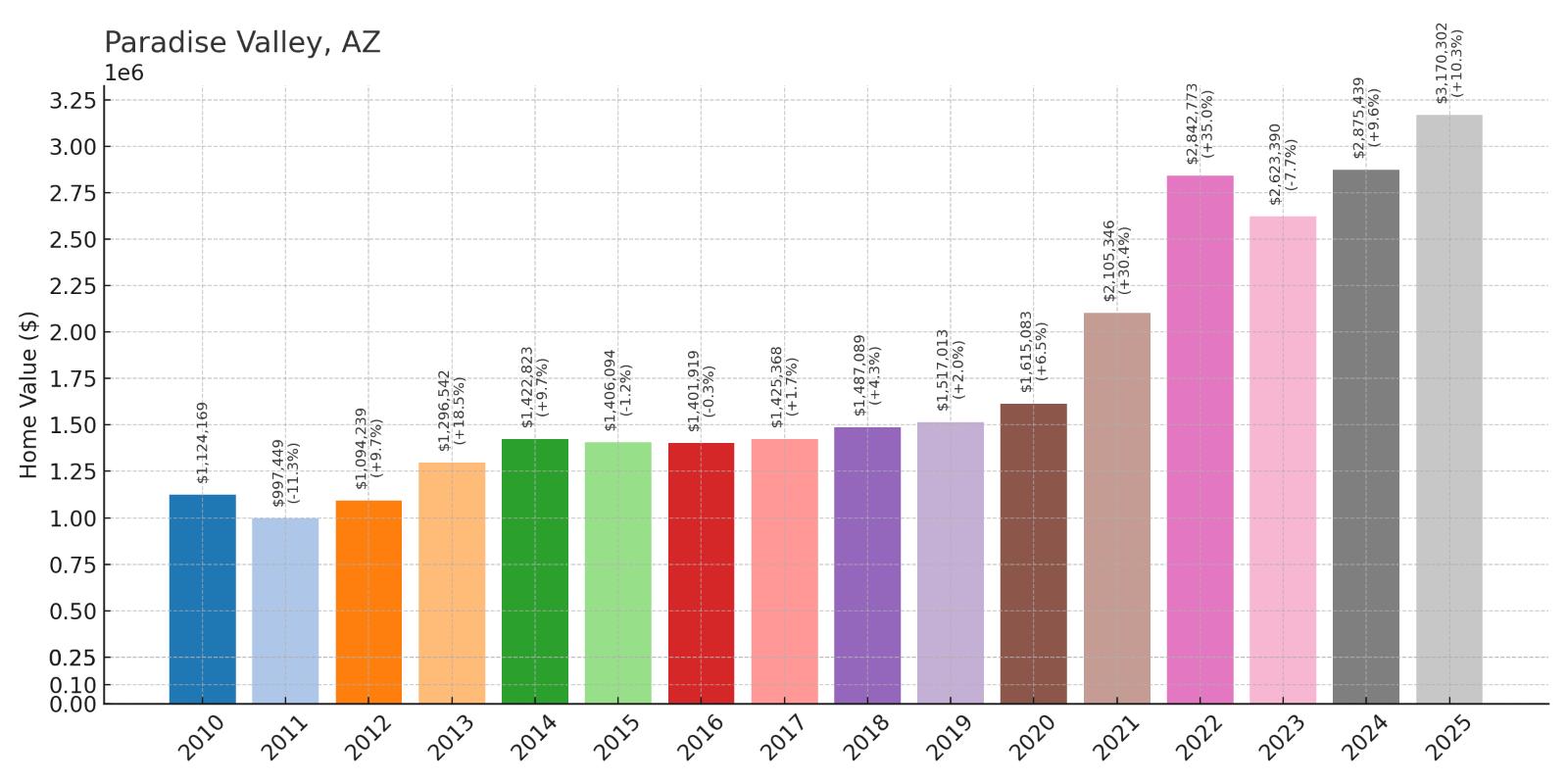
- 2010: $1,124,169
- 2011: $997,449
- 2012: $1,094,239
- 2013: $1,296,542
- 2014: $1,422,823
- 2015: $1,406,094
- 2016: $1,401,919
- 2017: $1,425,368
- 2018: $1,487,089
- 2019: $1,517,013
- 2020: $1,615,083
- 2021: $2,105,346
- 2022: $2,842,773
- 2023: $2,623,390
- 2024: $2,875,439
- 2025: $3,170,302
Paradise Valley achieved extraordinary 182% growth since 2010, starting from the highest baseline and reaching unprecedented luxury market levels. The town experienced steady appreciation before surging during 2020-2022, when values jumped from $1.6 million to over $2.8 million. Current median prices of $3,170,302 establish Paradise Valley as Arizona’s most expensive community by a substantial margin, reflecting its status as the ultimate destination for luxury real estate in the Southwest.
Why Paradise Valley?

Why are people willing to pay so much to live here? What’s special about it?
Paradise Valley attracts ultra-high-net-worth buyers seeking the pinnacle of luxury desert living with sprawling estates, celebrity neighbors, and unparalleled privacy in one of America’s most exclusive communities. The town offers custom mansions on large lots, world-class resorts, and dramatic mountain views while maintaining strict zoning that prevents commercial development and preserves residential tranquility. Residents value the ultimate exclusivity, sophisticated amenities, and iconic status that creates the most prestigious address in Arizona.
Unlike any other community, Paradise Valley combines massive lot sizes, architectural freedom, and natural beauty with proximity to Scottsdale’s amenities and Phoenix’s employment centers. The town’s commitment to maintaining low density and high standards creates an atmosphere of privilege and privacy that attracts celebrities, business leaders, and international buyers. Resort hotels, golf courses, and spa facilities provide world-class amenities while preserved desert areas maintain the natural beauty that enhances property values.
How Paradise Valley Rose to Prominence
Paradise Valley’s prominence began in the 1880s as cattle ranching country in the Salt River Valley, taking advantage of the area’s natural springs and grazing lands. The area remained largely agricultural until the post-World War II era when developers recognized its potential for luxury residential development, creating large-lot subdivisions that attracted affluent buyers seeking privacy and natural beauty near Phoenix.
The transformation to an ultra-luxury destination accelerated in the 1960s and 1970s with the development of world-class resorts like the Phoenician and Mountain Shadows, which established the area’s reputation for exclusivity and sophistication. The town’s incorporation in 1961 and commitment to strict zoning and architectural standards helped preserve the character and exclusivity that attracts the world’s wealthiest buyers. Today’s Paradise Valley represents the ultimate expression of luxury desert living, commanding the highest real estate prices in Arizona and ranking among America’s most expensive communities.
3 Interesting Tidbits
1. Celebrity Haven – Paradise Valley has been home to numerous celebrities, professional athletes, and business moguls, enhancing its reputation as an exclusive enclave.
2. Camelback Mountain – The iconic Camelback Mountain provides dramatic backdrops for luxury estates and hiking opportunities for residents seeking outdoor recreation.
3. Resort Hotels – World-renowned resorts like the Four Seasons and Hermosa Inn provide luxury amenities and enhance the area’s reputation as a destination for the ultra-wealthy.



